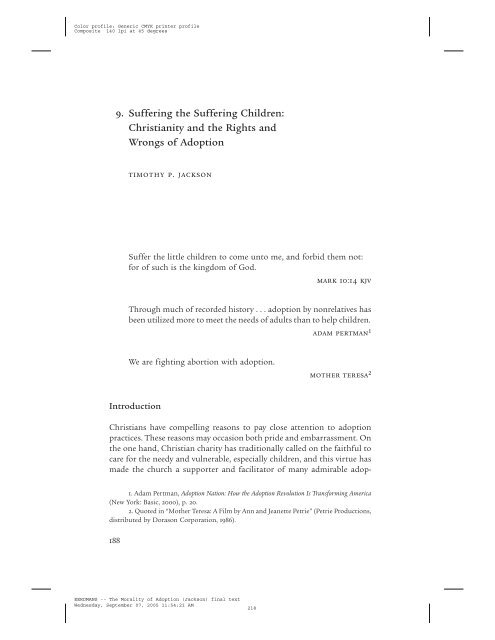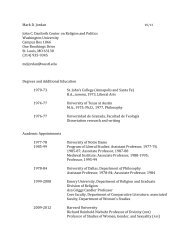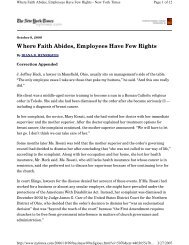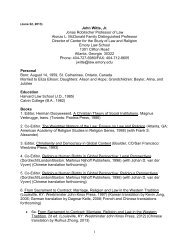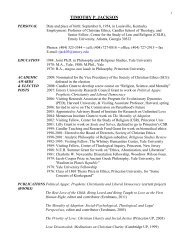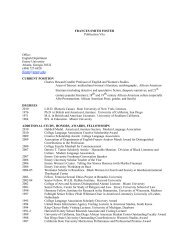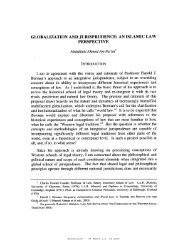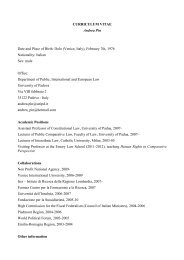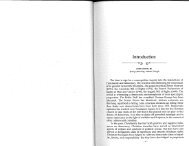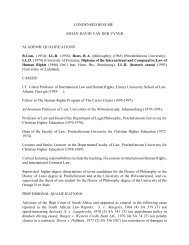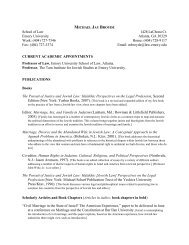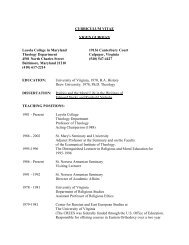Jackson: The Morality of Adoption Suffering the Suffering Children ...
Jackson: The Morality of Adoption Suffering the Suffering Children ...
Jackson: The Morality of Adoption Suffering the Suffering Children ...
You also want an ePaper? Increase the reach of your titles
YUMPU automatically turns print PDFs into web optimized ePapers that Google loves.
Color pr<strong>of</strong>ile: Generic CMYK printer pr<strong>of</strong>ileComposite 140 lpi at 45 degrees9. <strong>Suffering</strong> <strong>the</strong> <strong>Suffering</strong> <strong>Children</strong>:Christianity and <strong>the</strong> Rights andWrongs <strong>of</strong> <strong>Adoption</strong>timothy p. jacksonSuffer <strong>the</strong> little children to come unto me, and forbid <strong>the</strong>m not:for <strong>of</strong> such is <strong>the</strong> kingdom <strong>of</strong> God.mark 10:14 kjvThrough much <strong>of</strong> recorded history ...adoption by nonrelatives hasbeen utilized more to meet <strong>the</strong> needs <strong>of</strong> adults than to help children.adam pertman 1We are fighting abortion with adoption.mo<strong>the</strong>r teresa 2IntroductionChristians have compelling reasons to pay close attention to adoptionpractices. <strong>The</strong>se reasons may occasion both pride and embarrassment. On<strong>the</strong> one hand, Christian charity has traditionally called on <strong>the</strong> faithful tocare for <strong>the</strong> needy and vulnerable, especially children, and this virtue hasmade <strong>the</strong> church a supporter and facilitator <strong>of</strong> many admirable adop-1. Adam Pertman, <strong>Adoption</strong> Nation: How <strong>the</strong> <strong>Adoption</strong> Revolution Is Transforming America(New York: Basic, 2000), p. 20.2. Quoted in “Mo<strong>the</strong>r Teresa: A Film by Ann and Jeanette Petrie” (Petrie Productions,distributed by Dorason Corporation, 1986).188EERDMANS -- <strong>The</strong> <strong>Morality</strong> <strong>of</strong> <strong>Adoption</strong> (<strong>Jackson</strong>) final textWednesday, September 07, 2005 11:54:21 AM218
Color pr<strong>of</strong>ile: Generic CMYK printer pr<strong>of</strong>ileComposite 140 lpi at 45 degrees<strong>Suffering</strong> <strong>the</strong> <strong>Suffering</strong> <strong>Children</strong>tions. Christianity itself grew out <strong>of</strong> God’s “adoption” <strong>of</strong> <strong>the</strong> Gentiles, <strong>the</strong>gracious extension <strong>of</strong> a covenant to those not originally God’s people. Accordingto some accounts, Jesus himself was “adopted” ei<strong>the</strong>r by Joseph orby God. <strong>The</strong>refore, a positive attitude toward adoption is tied to <strong>the</strong> veryidentity <strong>of</strong> Christian belief and believers.On <strong>the</strong> o<strong>the</strong>r hand, various Christian ideals have served to condemncertain adoptions as unnatural or vicious, thus making life miserable forall those involved in <strong>the</strong> adoptive relation. For example, conceptions <strong>of</strong> adivine separation <strong>of</strong> <strong>the</strong> races have led some Christians to reject interracialadoption as against God’s will, even as conceptions <strong>of</strong> a divine endorsement<strong>of</strong> heterosexual monogamy have led o<strong>the</strong>r Christians to opposesingle-parent and gay or lesbian adoption.<strong>The</strong> issue is not simply whe<strong>the</strong>r Christian churches or individualsendorse or reject particular adoption practices; ra<strong>the</strong>r, it is how <strong>the</strong>se practicesare approached that makes a crucial difference. Even where adoptionis championed, <strong>the</strong> method may be cruel or counter-productive. Shamingunwilling or vulnerable young mo<strong>the</strong>rs into surrendering <strong>the</strong>ir <strong>of</strong>fspring,for instance, is itself a shameful practice, whe<strong>the</strong>r supposedly motivatedby Christian agape or not. Facilitating a willing transfer <strong>of</strong> parental oversightfor <strong>the</strong> sake <strong>of</strong> a better life for a child is, in contrast, to aid a Christlikeself-sacrifice.This chapter aims to clarify Christianity’s historical judgments <strong>of</strong>,and contributions to, adoption <strong>the</strong>ory and practice — admittedly, amixed picture. It has five sections. Section I examines how <strong>the</strong> Bible definesadoption, noting how a fundamental complexity here bears onChristian attitudes toward <strong>the</strong> practice. Section II looks at <strong>the</strong> rightsthat ground <strong>the</strong> moral and legal permissibility <strong>of</strong> adoption and how <strong>the</strong>yrelate to <strong>the</strong> Christian notion <strong>of</strong> sanctity. Section III investigates <strong>the</strong> ethics<strong>of</strong> single-parent and gay adoption as particularly pressing issues. SectionIV looks briefly at <strong>the</strong> right <strong>of</strong> adoptees to know <strong>the</strong>ir biologicalidentities and that <strong>of</strong> <strong>the</strong>ir birth parents. Finally, in Section V, I return toexplicitly biblical <strong>the</strong>mes and ask how views on christology affect basicperceptions <strong>of</strong> adoption.My enduring assumption is unremarkable but worth stating: nomo<strong>the</strong>r or fa<strong>the</strong>r should be intimidated, shamed, or coerced into surrenderingher or his child for adoption, unless <strong>the</strong> parent is demonstrablynegligent or abusive, but voluntary adoption is sometimes <strong>the</strong> most lovingact for <strong>the</strong> child and by <strong>the</strong> birth parent. My specific <strong>the</strong>ses are moresubstantive and controversial: (a) adoption is not merely <strong>the</strong> bestowal <strong>of</strong> anew (legally created) identity but also <strong>the</strong> acknowledgement <strong>of</strong> a pre-189EERDMANS -- <strong>The</strong> <strong>Morality</strong> <strong>of</strong> <strong>Adoption</strong> (<strong>Jackson</strong>) final textWednesday, September 07, 2005 11:54:21 AM219
Color pr<strong>of</strong>ile: Generic CMYK printer pr<strong>of</strong>ileComposite 140 lpi at 45 degreestimothy p. jacksonexisting (divinely created) humanity; (b) <strong>the</strong> primary adoption right isthat <strong>of</strong> orphaned, unwanted, destitute, or abused children to be adopted;(c) it is <strong>the</strong> sanctity <strong>of</strong> <strong>the</strong>se children’s lives, ra<strong>the</strong>r than <strong>the</strong>ir dignity, thatgives <strong>the</strong>m <strong>the</strong> positive right to be cared for by conscientious adults; 3 and(d) attention to <strong>the</strong> sanctity rights <strong>of</strong> adoptive children should move us topermit both single adults and same-sex couples to adopt.Traditional conceptions <strong>of</strong> Joseph and Mary, Jesus and God, canboth aid and hinder a proper appreciation <strong>of</strong> <strong>the</strong> morality <strong>of</strong> adoption, soChristian <strong>the</strong>ologians ought to make it abundantly clear why adoption is(or should be) an act <strong>of</strong> love ra<strong>the</strong>r than a shameful secret. As with artificialcontraception and assisted reproductive technology, this will requirereevaluating <strong>the</strong> ancient Alexandrian principle that having sex withoutgetting children and getting children without oneself having had sex areinherently illicit. <strong>The</strong> principle should be amended, I argue, but notmerely set aside.I. Biblical Definitions and a Key Complexity<strong>The</strong>re is no endorsement, or even explicit mention, <strong>of</strong> adoption as an ongoingpractice in Old Testament law. <strong>The</strong>re are, in effect, three referencesto acts <strong>of</strong> adoption — <strong>of</strong> Moses (Exod. 2:10), Genubath (1 Kings 11:20), andEs<strong>the</strong>r (Es<strong>the</strong>r 2:7, 15) — but, as is <strong>of</strong>ten noted, <strong>the</strong>se all take place outside<strong>of</strong> Palestine and thus in contexts foreign to Jewish rule and custom. 4 Torahtradition as such simply does not admit that someone who is notone’s biological child can be rendered one’s son or daughter by legal act(see <strong>the</strong> essay in this volume by Michael Broyde). It was Saint Paul wh<strong>of</strong>irst introduced <strong>the</strong> notion <strong>of</strong> adoption into Judeo-Christian <strong>the</strong>ology.<strong>The</strong> New Testament Greek word translated by <strong>the</strong> NRSV as “adoption”is huio<strong>the</strong>sia, from huios (meaning “son”) and ti<strong>the</strong>mi (meaning “to putor place”). <strong>The</strong> term appears five times in Paul’s epistles (Rom. 8:15; 8:23;9:4; Gal. 4:5; and Eph. 1:5), but not once in <strong>the</strong> Gospels. Construed literally,huio<strong>the</strong>sia is gendered and connotes a placing or taking in <strong>of</strong> someoneas a male heir. <strong>The</strong> International Standard Bible Encyclopedia (ISBE) defines3. A negative right is a claim not to be interfered with, not to have something takenfrom one, while a positive right is a claim to be actively assisted, to have something providedfor one independently <strong>of</strong> personal effort or merit.4. My colleague Hendrik Boers has pointed out to me that, although <strong>the</strong>se adoptionlocations were outside <strong>of</strong> Jewish rule, <strong>the</strong> stories are not simply records <strong>of</strong> <strong>the</strong> incidents anddo partly reflect Jewish custom.190EERDMANS -- <strong>The</strong> <strong>Morality</strong> <strong>of</strong> <strong>Adoption</strong> (<strong>Jackson</strong>) final textWednesday, September 07, 2005 11:54:21 AM220
Color pr<strong>of</strong>ile: Generic CMYK printer pr<strong>of</strong>ileComposite 140 lpi at 45 degrees<strong>Suffering</strong> <strong>the</strong> <strong>Suffering</strong> <strong>Children</strong><strong>the</strong> word, generally, as “<strong>the</strong> legal process by which a man might bring intohis family, and endow with <strong>the</strong> status and privileges <strong>of</strong> a son, one who wasnot by nature his son or <strong>of</strong> his kindred.” 5 One can readily see why Paul —that liminal figure at <strong>the</strong> dividing line between <strong>the</strong> historical Jesus and<strong>the</strong> Holy Spirit, Judaism and Christianity, Rome and barbarism — wouldhave been attracted to adoption metaphors. In many ways, he knew himselfto have been an outsider graciously allowed in: a man who never met<strong>the</strong> historical Jesus called never<strong>the</strong>less to be an apostle, a persecutor <strong>of</strong> <strong>the</strong>early Christian church converted into its greatest champion, as well as aPharisaic Jew enabled to be a Roman citizen. It was definitive <strong>of</strong> Paul’s geniusthat he saw in his personal experiences a model <strong>of</strong> God’s way with<strong>the</strong> wider world and was able to translate this into a powerful message <strong>of</strong>gifted salvation: “when <strong>the</strong> fullness <strong>of</strong> time had come, God sent his Son,born <strong>of</strong> a woman, born under <strong>the</strong> law, in order to redeem those who wereunder <strong>the</strong> law, so that we might receive adoption as children” (Gal. 4:4-5NRSV).<strong>The</strong> ISBE’s general definition <strong>of</strong> adoption captures Paul’s central<strong>the</strong>ological usage, but it also hides an important complexity. In <strong>the</strong>Greco-Roman culture against whose background Paul wrote, <strong>the</strong> “placing”associated with huio<strong>the</strong>sia 6 evidently involved ei<strong>the</strong>r (1) <strong>the</strong> production<strong>of</strong> a new (legal) identity for someone who was not a natural son, or (2) <strong>the</strong>affirmation <strong>of</strong> a pre-existing (legal) identity <strong>of</strong> someone who was in fact anatural son. 7 “<strong>Adoption</strong>” entailed, that is, ei<strong>the</strong>r <strong>the</strong> generation <strong>of</strong> an entirelynovel filial status or <strong>the</strong> recognition and formal celebration <strong>of</strong> a filialstatus that was already real, though perhaps denied, occluded, or onlypartially realized. When a Roman boy came <strong>of</strong> legal age, for instance, hemight be said to be “taken in” or “adopted” by his fa<strong>the</strong>r as heir. Or whena prodigal son mended his ways and returned to his home and biologicalfamily, his fa<strong>the</strong>r might welcome him and “place” him back into <strong>the</strong> domesticfold as again a son. <strong>The</strong> first case is a rite <strong>of</strong> passage in which a5. T. Rees, entry for “<strong>Adoption</strong>,” §IV, in <strong>The</strong> International Standard Bible Encyclopedia,ed. James Orr, Search God’s Word website, http://www.searchgodsword.org/enc/isb/view.cgi?number=T221. Accessed 10 April 2004. This view is shared by Easton’s Bible Dictionary,which defines “adoption” as “<strong>the</strong> giving to anyone <strong>the</strong> name and place and privileges<strong>of</strong> a son who is not a son by birth” (“<strong>Adoption</strong>,” Bible Tools website, http://bibletools.org//index.cfm/fuseaction/Def.show/RTD/Easton/Topic/<strong>Adoption</strong>. Accessed 10 April 2004).6. <strong>The</strong> Latin equivalent is adoptio or arrogatio (adrogatio), depending on whe<strong>the</strong>r <strong>the</strong>son is or is not still under his birth fa<strong>the</strong>r’s legal authority (patria potestas).7. See W. E. Vine, Merrill F. Unger, and William White Jr., Vine’s Complete ExpositoryDictionary <strong>of</strong> Old and New Testament Words (Nashville: Thomas Nelson, 1996), s.v. “adoption.”191EERDMANS -- <strong>The</strong> <strong>Morality</strong> <strong>of</strong> <strong>Adoption</strong> (<strong>Jackson</strong>) final textWednesday, September 07, 2005 11:54:21 AM221
Color pr<strong>of</strong>ile: Generic CMYK printer pr<strong>of</strong>ileComposite 140 lpi at 45 degreestimothy p. jacksonpresent identity is fulfilled, while <strong>the</strong> second case is a painful trial inwhich a proper identity is rediscovered. But both are very different from atransformation in which an altoge<strong>the</strong>r alien identity is conferred. Even ifa biological son has, in some sense, publicly to grow into himself, this“adoptive” process is one <strong>of</strong> maturation in which intrinsic attributes areunfolded, ra<strong>the</strong>r than a whole-cloth change imported or imposed fromwithout.<strong>The</strong> pressing question asks itself: Is <strong>the</strong> “adoption” referred to byPaul in Ephesians, Romans, and elsewhere <strong>the</strong> production <strong>of</strong> a new identityor <strong>the</strong> affirmation <strong>of</strong> an old one? Is <strong>the</strong> adoptive operation an “artificial”contrivance engineered by God alone, or does it have an “ontological”basis in human nature? Putting <strong>the</strong> query yet a third way, do evenelect human beings come short <strong>of</strong> being naturally God’s children, suchthat Christ’s agency changes <strong>the</strong>ir very essence, or does <strong>the</strong> Messiah’s life,death, and resurrection reveal a filial relation with God <strong>the</strong> Fa<strong>the</strong>r that isalready (part <strong>of</strong>) humanity’s birthright?I can only sum up <strong>the</strong> studied ambivalence <strong>of</strong> <strong>the</strong> Christian traditionby answering “both/and.” Many orthodox <strong>the</strong>ologians have held thatbeing made “in <strong>the</strong> image <strong>of</strong> God” (Gen. 1:27) is an empirical fact abouthumanity, and that this created identity constitutes a “resemblance to” or“consanguinity with” God, in some analogical sense. 8 We are by natureGod’s “children,” ra<strong>the</strong>r than God’s accidents, playthings, or victims, andeven <strong>the</strong> fall into sin has not totally destroyed this “genetic” legacy. Evenso, <strong>the</strong> infinite qualitative difference between creature and Creator remains.Only Christ, <strong>the</strong> second person <strong>of</strong> <strong>the</strong> Trinity, is <strong>of</strong> one substancewith <strong>the</strong> Fa<strong>the</strong>r; only Christ, <strong>the</strong> eternal Son, is begotten not made. Moreover,after <strong>the</strong> dawn <strong>of</strong> sin, Christ’s redemptive act on <strong>the</strong> cross is an indispensablemeans <strong>of</strong> restoring right relation with God. <strong>The</strong> believer’s adoptionas son or daughter, his or her being filled with <strong>the</strong> Holy Spirit so asto address <strong>the</strong> Deity with “Abba” (Rom. 8:15-17), is not simply a recognition<strong>of</strong> a pre-existing reality but is also a “new creation” (2 Cor. 5:17). <strong>The</strong>new creation must have some continuity with <strong>the</strong> old — how else can I saythat it is I who am saved? — but it is not enough to be reminded that weare images <strong>of</strong> God. We must be not merely edified, but ransomed, as a freeman might purchase a slave out <strong>of</strong> captivity (cf. Rom. 7:14). All are in8. Some <strong>the</strong>ologians — e.g., Karl Barth, Helmut Thielicke, and Karen Lebacqz — prefertosee<strong>the</strong>imago,or what is sometimes referred to as <strong>the</strong> “dignity” <strong>of</strong> human life, as a relationalphenomenon, a matter <strong>of</strong> God’s grace ra<strong>the</strong>r than anything inherent in human beings.As understandable as this is as a safeguard against both pride and despair, however, itthreatens <strong>the</strong> biblical doctrine <strong>of</strong> <strong>the</strong> goodness <strong>of</strong> creation.192EERDMANS -- <strong>The</strong> <strong>Morality</strong> <strong>of</strong> <strong>Adoption</strong> (<strong>Jackson</strong>) final textWednesday, September 07, 2005 11:54:21 AM222
Color pr<strong>of</strong>ile: Generic CMYK printer pr<strong>of</strong>ileComposite 140 lpi at 45 degrees<strong>Suffering</strong> <strong>the</strong> <strong>Suffering</strong> <strong>Children</strong>bondage to <strong>the</strong> law and to sin (Rom. 3:9), and no amount <strong>of</strong> repentant introspectionor just external action can liberate us. Still, God does not justannihilate <strong>the</strong> old order, God redeems it.Indeed, Christ wins for <strong>the</strong> faithful even more than Adam lost in <strong>the</strong>fall. <strong>The</strong> elect are eventually sealed in permanent and loving communionwith God beyond anything experienced by <strong>the</strong> innocent first parents in<strong>the</strong> Garden. <strong>The</strong> adoption made possible by <strong>the</strong> Redeemer builds on incarnatehuman nature, so to speak, but it is, most dramatically, an inbreaking<strong>of</strong> eternity into time. As such, our adoption is itself incomplete,both here and not yet. Through <strong>the</strong> practice <strong>of</strong> faith, hope, and love, humanbeings can have a foretaste <strong>of</strong> <strong>the</strong> new creation in history (“<strong>the</strong> firstfruits <strong>of</strong> <strong>the</strong> Spirit”), but full adoption (“<strong>the</strong> redemption <strong>of</strong> our bodies”)comes only in heaven and must be awaited with patience (Rom. 8:18-25).In short, <strong>the</strong> distinction between sonship-created and sonshiprecognizedis not always clear-cut, in ei<strong>the</strong>r Roman society or biblical <strong>the</strong>ology.9 Ra<strong>the</strong>r than lamenting this complexity, however, we can andshould appreciate its implications for contemporary adoption. Even as <strong>the</strong>“sacred” adoption <strong>of</strong> individuals through Christ is partly God’s recreation<strong>of</strong> <strong>the</strong>m in <strong>the</strong> image <strong>of</strong> God’s Son and partly God’s affirmation <strong>of</strong> <strong>the</strong>m asalready made in God’s image, so <strong>the</strong> “secular” adoption <strong>of</strong> individualsthrough <strong>the</strong> courts should be seen as having two sides or moments. On <strong>the</strong>one hand, secular adoption as currently practiced is <strong>the</strong> bestowing <strong>of</strong> a newlegal identity on someone, male or female, who is not one’s biologicalprogeny. It is a matter <strong>of</strong> invention in <strong>the</strong> sense that filial rights and responsibilitiesnow obtain by judicial fiat, where formerly <strong>the</strong>re had been none.On <strong>the</strong> o<strong>the</strong>r hand, secular adoption is also <strong>the</strong> recognition <strong>of</strong> <strong>the</strong> sharedhumanity <strong>of</strong> <strong>the</strong> one adopted, his or her needs and potentials. In spite <strong>of</strong>loose talk about “adopting” a highway or a tree, <strong>the</strong> adoption that inauguratesa novel civic identity and familial relation is not purely arbitrary. Positivelaw does not generate human beings, or even legal heirs, ex nihilo. <strong>The</strong>reare reasons why someone is or ought to be adopted, reasons stemmingfrom our discovery <strong>of</strong> his or her indelible sanctity. Or so I will argue.9. Even <strong>the</strong> possible senses in which Jesus was adopted, ei<strong>the</strong>r by God or by Joseph,have been much debated by Christians. When, for example, God says <strong>of</strong> Jesus, “You are mySon, <strong>the</strong> Beloved; with you I am well pleased” (Mark 1:11 NRSV, at Jesus’ baptism) or “This ismy Son, <strong>the</strong> Beloved; listen to him” (Mark 9:7 NRSV, at Jesus’ transfiguration), is this astatement that describes reality, a performative that alters it, or perhaps both? <strong>The</strong> questionbecomes particularly complicated when one compares parallel passages, such as Mat<strong>the</strong>w3:17 and 17:5. I will return to <strong>the</strong> question <strong>of</strong> Jesus’ nature in Section V, but here I focuson humanity’s “adoption as sons” (Gal. 4:5 RSV) and how it bears on civil adoption.193EERDMANS -- <strong>The</strong> <strong>Morality</strong> <strong>of</strong> <strong>Adoption</strong> (<strong>Jackson</strong>) final textWednesday, September 07, 2005 11:54:21 AM223
Color pr<strong>of</strong>ile: Generic CMYK printer pr<strong>of</strong>ileComposite 140 lpi at 45 degreestimothy p. jacksonLet me now elaborate on <strong>the</strong> meaning <strong>of</strong> sanctity by first contrastingit with dignity and <strong>the</strong>n relating both notions to <strong>the</strong> idea <strong>of</strong> rights.II. Dignity, Sanctity, and <strong>The</strong>ir Correlative Rights“Dignity,” as I define it, is a contingent achievement: a function <strong>of</strong> ei<strong>the</strong>r<strong>the</strong> meritorious exercise <strong>of</strong> personal agency or, minimally, <strong>the</strong> bare possession<strong>of</strong> such agency. In ei<strong>the</strong>r case, dignity inheres only in individuals sufficientlymature to be aware <strong>of</strong> <strong>the</strong>mselves and <strong>the</strong>ir intentional plansacross time. Dignity requires, that is, a robust sense <strong>of</strong> self. (<strong>The</strong> Latinterm dignitas means “a being worthy” and originally applied to those fewpersons or political <strong>of</strong>fices filled with grandeur and authority. 10 )Entailingan admirable or powerful display <strong>of</strong> self-governance, dignity, inturn, inspires respect in o<strong>the</strong>rs. <strong>The</strong> dignity <strong>of</strong> persons, <strong>the</strong>ir rational autonomy,moved Immanuel Kant, for instance, to insist that <strong>the</strong>y be treatedas ends and not as means only. 11 Free agents are intrinsically valuable andnot merely instruments to <strong>the</strong> maximization <strong>of</strong> o<strong>the</strong>rs’ utility.Only persons, defined as autonomous subjects, have dignity. Ins<strong>of</strong>aras fetuses and infants are not yet self-conscious agents, <strong>the</strong>y lack dignityin <strong>the</strong> technical sense and thus are not <strong>the</strong> subjects <strong>of</strong> respect. <strong>The</strong>y arepre-persons. Ins<strong>of</strong>ar as <strong>the</strong> pr<strong>of</strong>oundly retarded are not and never will bemorally self-aware, <strong>the</strong>y too are without dignity. <strong>The</strong>y are nonpersons.And ins<strong>of</strong>ar as <strong>the</strong> permanently comatose and demented are no longer autonomous,<strong>the</strong>y are nondignified post-persons. 12If “dignity” refers to contingent personal achievement, “sanctity,” incontrast, refers to essential human nature. As I understand it, it is a function<strong>of</strong> universal human needs and potentials that do not presuppose selfawareness,self-control, or any o<strong>the</strong>r temporal attainment. (<strong>The</strong> Latinword sanctitas denotes “inviolability, sacredness” and was originally athome in a religious context. 13 ) <strong>The</strong> relevant qualities include <strong>the</strong> need for10. See Charlton T. Lewis and Charles Short, A Latin Dictionary (New York: OxfordUniversity Press, 1987), s.v. dignitas.11. Immanuel Kant, <strong>The</strong> Critique <strong>of</strong> Practical Reason, 5:87, in <strong>The</strong> Cambridge Edition <strong>of</strong> <strong>the</strong>Works <strong>of</strong> Immanuel Kant: Practical Philosophy, trans. Mary J. Gregor (Cambridge: CambridgeUniversity Press, 1996), p. 210.12. I do not mean to imply that Kant would conclude that fetuses, infants, <strong>the</strong> mentallyhandicapped, <strong>the</strong> comatose, and/or <strong>the</strong> demented may properly be treated as mere means toan end, but I do maintain that he gives us little or no basis on which to resist this conclusion.13. Lewis and Short, Latin Dictionary, s.v. sanctitas.194EERDMANS -- <strong>The</strong> <strong>Morality</strong> <strong>of</strong> <strong>Adoption</strong> (<strong>Jackson</strong>) final textWednesday, September 07, 2005 11:54:22 AM224
Color pr<strong>of</strong>ile: Generic CMYK printer pr<strong>of</strong>ileComposite 140 lpi at 45 degrees<strong>Suffering</strong> <strong>the</strong> <strong>Suffering</strong> <strong>Children</strong>food, shelter, clothing, and companionship, and/or <strong>the</strong> potential forgrowth, awareness, intelligence, emotion, and inspiration. If dignity callsforth respect, sanctity calls forth reverence; if dignity moves o<strong>the</strong>rs not tothwart one’s noumenal self, <strong>the</strong>n sanctity calls on o<strong>the</strong>rs to cultivate one’svulnerable soul. Shared human needs and potentials are not so much intrinsicallyvaluable as <strong>the</strong> necessary conditions for value itself. On myreading <strong>of</strong> <strong>the</strong> Christian tradition, <strong>the</strong> most basic form <strong>of</strong> sanctity is <strong>the</strong>need or ability to give or receive agapic love. To give or receive such love isto know eternal life, to be a child <strong>of</strong> God.And who, specifically, is a child <strong>of</strong> God? Even though fetuses, earlyinfants, <strong>the</strong> retarded, and <strong>the</strong> demented are not dignified “persons” (i.e.,not rational agents), <strong>the</strong>y are never<strong>the</strong>less sacred human beings. If, to repeat,<strong>the</strong> measure <strong>of</strong> sanctity is <strong>the</strong> need or ability to give or receive agapiclove, <strong>the</strong>n <strong>the</strong> very young, <strong>the</strong> very old, and <strong>the</strong> very diminished “count.”<strong>The</strong>y all share our human needs and can pr<strong>of</strong>itably receive love, even if<strong>the</strong>y cannot self-consciously give it.<strong>The</strong> sanctity <strong>of</strong> human lives has a claim on us that is utterly unearnedand entirely inalienable. I call this claim a “sanctity right,” and itstems from human need and/or potential; it has nothing to do with pastmerit or demerit, present contract or breach <strong>of</strong> contract, or future statusor lack <strong>of</strong> status. Moreover, <strong>the</strong> claim is not merely to inviolability, as in<strong>the</strong> case <strong>of</strong> dignity, but also to active assistance. Regardless <strong>of</strong> whe<strong>the</strong>r orphanedor unwanted children have been culpably injured by o<strong>the</strong>rs, for example,it is <strong>the</strong> duty <strong>of</strong> those responsible for <strong>the</strong> common good (bothchurch and state) to see to it that <strong>the</strong> children find a loving home. Tragicaccident or natural calamity may be responsible for <strong>the</strong> fate <strong>of</strong> <strong>the</strong>se children,but <strong>the</strong>ir “sanctity rights” to nurturance obtain in any case. <strong>The</strong>yhave, I maintain, a right to be adopted that precedes <strong>the</strong> interests andcontingent choices <strong>of</strong> would-be parents. 14 Those in authority have a duty14. <strong>The</strong>re is precedent for <strong>the</strong> right I am defending. Section 28 <strong>of</strong> <strong>the</strong> South AfricanConstitution, for example, specifies that “Every child has <strong>the</strong> right — . . . (b) to family orparental care, or to appropriate alternative care when removed from <strong>the</strong> family environment;. . [and] (d) to be protected from maltreatment, neglect, abuse or degradation”(quoted in Barbara Bennett Woodhouse, “<strong>The</strong> Constitutionalization <strong>of</strong> <strong>Children</strong>’s Rights:Incorporating Emerging Human Rights into Constitutional Doctrine,” University <strong>of</strong> PennsylvaniaJournal <strong>of</strong> Constitutional Law 2, no. 1 [December 1999], University <strong>of</strong> PennsylvaniaLaw website, http://www.law.upenn.edu/journals/conlaw/issues/vol2/num1/woodhouse/node5_tf.html). <strong>The</strong> South African document is marred, I believe, by its attempt to groundchildren’s rights in “dignity” ra<strong>the</strong>r than “sanctity,” but <strong>the</strong> overall thrust <strong>of</strong> its case isclear and cogent. See also <strong>the</strong> United Nations’ “Declaration <strong>of</strong> <strong>the</strong> Rights <strong>of</strong> <strong>the</strong> Child”195EERDMANS -- <strong>The</strong> <strong>Morality</strong> <strong>of</strong> <strong>Adoption</strong> (<strong>Jackson</strong>) final textWednesday, September 07, 2005 11:54:22 AM225
Color pr<strong>of</strong>ile: Generic CMYK printer pr<strong>of</strong>ileComposite 140 lpi at 45 degreestimothy p. jackson<strong>of</strong> charity to enlist and empower adoptive parents to care for needy children,ra<strong>the</strong>r than waiting for such parents to present <strong>the</strong>mselves or forsuch children to seem appealing. 15In our late capitalist culture, it is hard not to assume that all thingsare ei<strong>the</strong>r dignified persons or fungible property. It is hard, that is, to find<strong>the</strong> cultural space to recognize <strong>the</strong> sanctity <strong>of</strong> human life. If children areproducts with only use-value for <strong>the</strong>ir parents and/or <strong>the</strong> larger society,ra<strong>the</strong>r than human beings with sanctity in and <strong>of</strong> <strong>the</strong>mselves, <strong>the</strong>n <strong>the</strong>rights <strong>of</strong> would-be parents are consumer rights or property rights. If dignityrights are <strong>the</strong> only kind that are legally enforceable, as some have argued,16 <strong>the</strong>n being without dignity makes young children into mere commodities,at least for purposes <strong>of</strong> <strong>the</strong> law. How <strong>the</strong>y are treated — indeed,whe<strong>the</strong>r <strong>the</strong>y are suffered to live — is thus a matter <strong>of</strong> personal choice foro<strong>the</strong>rs ra<strong>the</strong>r than <strong>of</strong> human decency for <strong>the</strong>mselves. If, in contrast, evenpre-linguistic children have a sanctity that is morally and legally significant,<strong>the</strong>n <strong>the</strong> language <strong>of</strong> “free choice” and “consumer options” for adoptive(and biological) parents must give way to that <strong>of</strong> “human rights” and“loving care” for adopted children. 17I will eventually note <strong>the</strong> limits <strong>of</strong> <strong>the</strong> language <strong>of</strong> “rights” with respectto adoption, but <strong>the</strong> foregoing suggests an important clarification <strong>of</strong>that language. When talk <strong>of</strong> “rights” is used in adoption contexts, it is usuallywith reference to <strong>the</strong> negative rights <strong>of</strong> would-be parents to adopt, <strong>the</strong>ir rightnot to be legally restricted because <strong>of</strong> race, creed, gender, age, national origin,income level, marital status, or sexual orientation. This is a reflection<strong>of</strong> <strong>the</strong> fact that rights are normally attributed to autonomous adults, selfconsciousagents who have “personal dignity.” 18 Personal dignity rights are(1959) and “Convention on <strong>the</strong> Rights <strong>of</strong> <strong>the</strong> Child” (1989), especially Articles 20 and 21 <strong>of</strong><strong>the</strong> latter.15. Thomas Aquinas is at best misleading when he writes that “man does not makehim worthy whom he adopts; but ra<strong>the</strong>r in adopting him he chooses one who is alreadyworthy” (Aquinas, Summa <strong>The</strong>ologica, trans. Fa<strong>the</strong>rs <strong>of</strong> <strong>the</strong> English Dominican Province, IIIa,q. 23, a. 1 [Westminster, Md.: Christian Classics, 1981], p. 2141). Like all sanctity rights, <strong>the</strong>right to be adopted does not depend on achieved worthiness but on intrinsic nature.16. See, for instance, Ronald Dworkin, Life’s Dominion: An Argument about Abortion, Euthanasia,and Individual Freedom (New York: Knopf, 1993), and Peter Singer, Rethinking Life andDeath: <strong>The</strong> Collapse <strong>of</strong> Our Traditional Ethics (Oxford: Oxford University Press, 1995).17. On <strong>the</strong> perverting influence <strong>of</strong> consumerist language on our understanding <strong>of</strong>adoption, see Rickie Solinger, Beggars and Choosers: How <strong>the</strong> Politics <strong>of</strong> Choice Shapes <strong>Adoption</strong>,Abortion, and Welfare in <strong>the</strong> United States (New York: Hill and Wang, 2001).18. See my <strong>The</strong> Priority <strong>of</strong> Love: Christian Charity and Social Justice (Princeton, N.J.:Princeton University Press, 2003), especially ch. 5.196EERDMANS -- <strong>The</strong> <strong>Morality</strong> <strong>of</strong> <strong>Adoption</strong> (<strong>Jackson</strong>) final textWednesday, September 07, 2005 11:54:22 AM226
Color pr<strong>of</strong>ile: Generic CMYK printer pr<strong>of</strong>ileComposite 140 lpi at 45 degrees<strong>Suffering</strong> <strong>the</strong> <strong>Suffering</strong> <strong>Children</strong>important, but <strong>the</strong>y are not <strong>the</strong> only or even <strong>the</strong> most important variety <strong>of</strong>moral claim in adoption contexts. In fact, <strong>the</strong> impersonal interests <strong>of</strong>needy children are increasingly being placed center-stage in adoption debates.<strong>The</strong> positive sanctity rights <strong>of</strong> children to be adopted matter decisively.Once <strong>the</strong> difference between dignity rights and sanctity rights is recognized,we can appreciate <strong>the</strong> possible conflict between personal claimsby parents or society, on <strong>the</strong> one hand, and impersonal claims for adoptees,on <strong>the</strong> o<strong>the</strong>r. Does a woman who does not wish to carry a pregnancy toterm have <strong>the</strong> right to kill <strong>the</strong> fetus or only to be free <strong>of</strong> <strong>the</strong> burden <strong>of</strong> its(late) gestation and (later) child care? 19 How do we balance her dignity with<strong>the</strong> sanctity <strong>of</strong> <strong>the</strong> life she is carrying, a life which may eventually be put upfor adoption? Does an intermittently dysfunctional pair <strong>of</strong> birth parentshave <strong>the</strong> right to retrieve <strong>the</strong>ir children from foster care over and overagain, thus submitting <strong>the</strong> children to repeated traumas <strong>of</strong> dislocation?How do we weigh <strong>the</strong> claims <strong>of</strong> blood against <strong>the</strong> well-being <strong>of</strong> <strong>the</strong> brood?In cases <strong>of</strong> transracial or transnational adoption, do <strong>the</strong> adoptive parentshave <strong>the</strong> right to choose <strong>the</strong> culture and/or religion in which <strong>the</strong>ir childrenwill be raised, or should <strong>the</strong>y feel obliged to learn about <strong>the</strong> race and nativecreed <strong>of</strong> <strong>the</strong>ir adoptive <strong>of</strong>fspring and teach <strong>the</strong>m about <strong>the</strong> same? How, insuch cases, do we promote what much <strong>of</strong> <strong>the</strong> Christian tradition hastaught should be a central concern <strong>of</strong> well-ordered sexuality: <strong>the</strong> care andeducation <strong>of</strong> children? 20 Do heterosexual couples have <strong>the</strong> exclusive rightto adopt, when single parents or gay couples might provide a more caringhome for <strong>the</strong> children? How do we substantiate or gainsay <strong>the</strong> traditionaljudgment that gay and lesbian relations are intrinsically disordered,“abominations” or “degrading passions” that are “unnatural” and “contraryto right reason”? 21We can only begin to adjudicate <strong>the</strong> “rights” and “wrongs” <strong>of</strong> adoptionby placing primacy on <strong>the</strong> sanctity rights <strong>of</strong> needy children. Whatsuffering children need most is a secure and loving environment, and <strong>the</strong>19. Early on in pregnancy, <strong>the</strong> only way to escape <strong>the</strong> burden <strong>of</strong> gestation is an abortionthat kills <strong>the</strong> embryo or fetus, but after about <strong>the</strong> twenty-third week, a C-section can<strong>of</strong>ten lead to “live birth” and thus to <strong>the</strong> possibility <strong>of</strong> adoption. Moreover, technology ispushing <strong>the</strong> survival date for “premies” fur<strong>the</strong>r and fur<strong>the</strong>r back. Although it strikes me asa Gnostic nightmare, we may eventually see MEG (mechanical external gestation) removepregnancy from <strong>the</strong> female body altoge<strong>the</strong>r.20. See, for example, Thomas Aquinas, Summa <strong>The</strong>ologica, “Supplement to Part 3,”q. 49.21. See, for example, Lev. 18:22; Rom. 1:26-27; and Aquinas, Summa <strong>The</strong>ologica, IIa IIae,q. 154, aa. 11 and 12.197EERDMANS -- <strong>The</strong> <strong>Morality</strong> <strong>of</strong> <strong>Adoption</strong> (<strong>Jackson</strong>) final textWednesday, September 07, 2005 11:54:22 AM227
Color pr<strong>of</strong>ile: Generic CMYK printer pr<strong>of</strong>ileComposite 140 lpi at 45 degreestimothy p. jacksonbest interests <strong>of</strong> <strong>the</strong>se children dictate that <strong>the</strong>y be placed in whatever situationbest promises such ongoing support. Keeping biologically relatedfamilies intact remains an important goal, but it does not trump all o<strong>the</strong>rfactors. Ra<strong>the</strong>r than social service <strong>of</strong>fices always struggling to return fostercare infants to <strong>the</strong>ir birth parents, which <strong>of</strong>ten means shuttling <strong>the</strong> infantsback and forth between volatile homes and multiple caretakers, <strong>the</strong>governing ideal is rightly stability and permanence. 22 <strong>The</strong> rights <strong>of</strong> <strong>the</strong> biologicalparents may be forfeited if <strong>the</strong>y are repeatedly drug dependent,abusive, neglectful, or o<strong>the</strong>rwise unwilling or unable to care consistentlyfor <strong>the</strong>ir children. Conversely, some single, gay, disabled, and older parentsare equally capable <strong>of</strong> attending to <strong>the</strong> needs and potentials <strong>of</strong> adoptivechildren as some married, heterosexual, healthy, and younger couples.In o<strong>the</strong>r words, agape can and does govern many “nontraditional” relationsand households, even as it governs many traditional ones.Once we acknowledge that “natural” family bonds can be severedfrom within, and that this severance licenses <strong>the</strong> state to intervene, <strong>the</strong>nwe must affirm a “political” right to be adopted or else we are simplywhistling in <strong>the</strong> dark. If <strong>the</strong>re is no right to be adopted, <strong>the</strong>n it may actuallybe hurtful to hold up stability and permanence as child-care desiderata,since <strong>the</strong>se will seem cruel illusions to many in distress. To insist on aneedy child’s right to be adopted is not, need I say, to imply that each individualin society has a personal duty to adopt. Quite specific circumstancesmay occasionally translate into a perfect duty to adopt, at least for aChristian, as when one’s sibling and his or her spouse both die, leavingone’s niece or nephew orphaned. But <strong>the</strong>se cases are rare. I am maintaining,ra<strong>the</strong>r, that society as a whole has an imperfect duty to provide adequateadoption possibilities for its members. 23 In addition to <strong>the</strong> directclaim that sanctity has on us, <strong>the</strong> motive for this duty <strong>of</strong> beneficence maybe found, in part, in a collective sense <strong>of</strong> gratitude for <strong>the</strong> unearned carethat we ourselves have received — starting, if we are lucky, with our parentsbut including essential social services to which we have not antecedentlycontributed. <strong>The</strong> primary motive for Christians, however, is notintra-human indebtedness or reciprocity; it stems from <strong>the</strong> fact that weare loved first by God and are called on, in turn, to incarnate a holy willtoward our neighbors (1 John 4:10-21). In spite <strong>of</strong> human powerlessness22. Cf. Pertman, <strong>Adoption</strong> Nation, p. 215.23. A perfect duty specifies precise details <strong>of</strong> obligatory action and <strong>of</strong>ten applies to aparticular person, whereas an imperfect duty leaves more room to maneuver and <strong>of</strong>ten appliesto a group.198EERDMANS -- <strong>The</strong> <strong>Morality</strong> <strong>of</strong> <strong>Adoption</strong> (<strong>Jackson</strong>) final textWednesday, September 07, 2005 11:54:22 AM228
Color pr<strong>of</strong>ile: Generic CMYK printer pr<strong>of</strong>ileComposite 140 lpi at 45 degrees<strong>Suffering</strong> <strong>the</strong> <strong>Suffering</strong> <strong>Children</strong>and sin (Rom. 5:6-8), human needs and potentials are attended to by <strong>the</strong>God who is agapic love, and finite agents are commanded to do likewise.In baptism, <strong>the</strong> whole congregation promises to help raise <strong>the</strong> child,so <strong>the</strong>re is a <strong>the</strong>ological model <strong>of</strong> <strong>the</strong> kind <strong>of</strong> communal responsibility Ihave in mind. Moreover, adoption services need not always be handledgovernmentally, through <strong>the</strong> state. Churches and o<strong>the</strong>r nonpr<strong>of</strong>it organizationsand communities can take on <strong>the</strong> responsibilities involved, with<strong>the</strong> state applauding and licensing, but not directly running, a host <strong>of</strong>faith-based or social-justice-based initiatives. 24 Such initiatives have <strong>the</strong>virtue <strong>of</strong> keeping family creation close to <strong>the</strong> parties most immediately involved,in accordance with <strong>the</strong> principle <strong>of</strong> subsidiarity. 25 Some worrythat “independent” adoptions that work outside <strong>of</strong> governmental agenciesare readily corrupted by financial incentives, and <strong>the</strong> so-called “graymarket” in adoptable children does at times approximate baby selling. Soeven a proponent <strong>of</strong> subsidiarity, such as myself, must affirm <strong>the</strong> state’sproper (if limited) place in regulating adoption procedures.To flesh out and back up <strong>the</strong>se claims, let me examine in more detailtwo forms <strong>of</strong> adoption called by some “abominable” and by o<strong>the</strong>rs “liberating”:single and homosexual adoption. <strong>The</strong>se forms <strong>of</strong> adoption clearlychallenge traditional conceptions <strong>of</strong> sex, marriage, and <strong>the</strong> family. Buthow should we understand <strong>the</strong>m, morally, when focus is on <strong>the</strong> sanctity<strong>of</strong> <strong>the</strong> children involved, ra<strong>the</strong>r than <strong>the</strong> dignity <strong>of</strong> <strong>the</strong> would-be adoptiveparents or <strong>the</strong> utility <strong>of</strong> <strong>the</strong> general society?III. Abomination, Liberation, andTwo Controversial Forms <strong>of</strong> <strong>Adoption</strong>Nontraditional adoption crosses time-honored boundaries (for example,<strong>of</strong> race and ethnicity) and/or calls into question <strong>the</strong> meaning <strong>of</strong> genderin marriage (as in, for example, gay and lesbian unions). Sometimes <strong>the</strong>undermining <strong>of</strong> social divisions or <strong>the</strong> blurring <strong>of</strong> familial boundaries isdeeply troubling and harmful. Most <strong>of</strong> us would agree, for instance, that<strong>the</strong> Bible rightly calls incest, child-sacrifice, and bestiality “abominations”(Lev. 18:6-30). <strong>The</strong> devastating effects <strong>of</strong> <strong>the</strong>se practices are welldocumented.At o<strong>the</strong>r times, however, past distinctions between groupsor types <strong>of</strong> people are <strong>the</strong>mselves destructive and in need <strong>of</strong> subversion.24. I wish to thank Brent Waters, Mary Stewart Van Leeuwen, Stephen Presser, andJohn Witte for helping me to clarify <strong>the</strong> points made in this paragraph.25. For more on this principle, see <strong>the</strong> essay by Lisa Cahill in this volume.199EERDMANS -- <strong>The</strong> <strong>Morality</strong> <strong>of</strong> <strong>Adoption</strong> (<strong>Jackson</strong>) final textWednesday, September 07, 2005 11:54:22 AM229
Color pr<strong>of</strong>ile: Generic CMYK printer pr<strong>of</strong>ileComposite 140 lpi at 45 degreestimothy p. jacksonFew <strong>of</strong> us would now applaud <strong>the</strong> idea that it is an “abomination” for <strong>the</strong>Egyptians to eat with <strong>the</strong> Hebrews (Gen. 43:32) or an incitement to “prostitution”for ethnic groups to intermarry (Exod. 34:16). 26Is nontraditional adoption necessarily abominable, or might it actuallybe liberating for all concerned? <strong>The</strong> basic meaning <strong>of</strong> <strong>the</strong> word“abominable” is indicated by its etymology, which <strong>The</strong> Oxford English Dictionarynotes is ei<strong>the</strong>r absit + omen or ab + homine. 27 <strong>The</strong> former possibility,which I will call “<strong>the</strong> <strong>the</strong>ological reading,” is <strong>the</strong> older <strong>of</strong> <strong>the</strong> two and construes<strong>the</strong> abominable as what is without good omen or God’s blessing,what <strong>of</strong>fends <strong>the</strong> Fates or incurs God’s wrath. <strong>The</strong> latter, “anthropological”reading entered <strong>the</strong> English language through John Wycliffe’s 1382translation <strong>of</strong> <strong>the</strong> Bible — he and his associates followed <strong>the</strong> FrenchMedievals in spelling “abhominable” with an “h” — and sees <strong>the</strong> abominableas what departs from or destroys <strong>the</strong> essentially human. 28As with “abomination,” two general readings <strong>of</strong> “liberation” are possible.<strong>The</strong> Latin root <strong>of</strong> <strong>the</strong> word “liberate” (liber) means “free”; 29 but <strong>the</strong>reare at least two possible elaborations <strong>of</strong> this freedom, elaborations as oldas Augustine: mere freedom <strong>of</strong> choice (liberum arbitrium) or <strong>the</strong> more holisticnotion <strong>of</strong> good disposition, candor, and personal integrity (libertas).Bare freedom <strong>of</strong> choice (liberty <strong>of</strong> indifference) refers exclusively to <strong>the</strong>will and says nothing about <strong>the</strong> ends to which free choice is put, whilelibertas is a more normative notion in which <strong>the</strong> whole person (ra<strong>the</strong>r thanjust <strong>the</strong> will) flourishes. Liberation in <strong>the</strong> sense associated with libertas entailsmore than having an external encumbrance removed. We do speak <strong>of</strong>“liberating” a town, say, when we mean delivering it from foreign occupation;but <strong>the</strong> most robust sense <strong>of</strong> “liberation” involves internal empowerment,a revolution in <strong>the</strong> soul ra<strong>the</strong>r than in its circumstances, an immenseheightening <strong>of</strong> crucial capacities.If love is from God and God himself is love (1 John 4:7-8), and if <strong>the</strong>fundamental human need and capacity is to come into loving relationwith God and o<strong>the</strong>r human beings (Matt. 22:36-40), <strong>the</strong>n we have a basicdefinition <strong>of</strong> both “abomination” and “liberation.” <strong>The</strong> abominable is26. Old prejudices die hard, <strong>of</strong> course; Anwar Sadat was assassinated, in part, preciselyfor being civil to Menachem Begin.27. <strong>The</strong> Compact Edition <strong>of</strong> <strong>the</strong> Oxford English Dictionary, vol. 1 (Oxford: Oxford UniversityPress, 1984), s.v. “abomination.”28. This paragraph and <strong>the</strong> ones that immediately follow borrow extensively from myLove Disconsoled: Meditations on Christian Charity (Cambridge: Cambridge University Press,1999), ch. 4.29. <strong>The</strong> Compact Edition <strong>of</strong> <strong>the</strong> Oxford English Dictionary, s.v. “liberation.”200EERDMANS -- <strong>The</strong> <strong>Morality</strong> <strong>of</strong> <strong>Adoption</strong> (<strong>Jackson</strong>) final textWednesday, September 07, 2005 11:54:22 AM230
Color pr<strong>of</strong>ile: Generic CMYK printer pr<strong>of</strong>ileComposite 140 lpi at 45 degrees<strong>Suffering</strong> <strong>the</strong> <strong>Suffering</strong> <strong>Children</strong>what fundamentally thwarts or destroys <strong>the</strong> potential to love or be loved,while <strong>the</strong> liberating is what fundamentally expands or generates this potential.To be capable <strong>of</strong> loving care is to be capable <strong>of</strong> knowing and pleasingGod and <strong>of</strong> fur<strong>the</strong>ring human beings as <strong>the</strong>mselves <strong>of</strong> intrinsic worth,while to be in need <strong>of</strong> loving care is to need valuing by God and o<strong>the</strong>rs. Tocare for human beings as such is to value <strong>the</strong>ir status as (real or potential)valuers, and to need care from o<strong>the</strong>r human beings is to require <strong>the</strong>ir valuationin order to acquire moral ends <strong>of</strong> one’s own. Personal care is, ino<strong>the</strong>r words, self-conscious and o<strong>the</strong>r-regarding. Yet, more important, developingpersonhood, becoming ourselves, requires that o<strong>the</strong>rs extend tous gratuitous attention before we are self-conscious agents. Because <strong>of</strong><strong>the</strong>ir need and potential to give and receive love — what I have called <strong>the</strong>ir“sanctity” — <strong>the</strong> pre-personal lives <strong>of</strong> children have pr<strong>of</strong>ound worth. Notuntil full personhood is actualized do our lives self-consciously matter tous: only <strong>the</strong>n do we value ourselves as valuers. But <strong>the</strong> need and potentialfor agapic love, even in fetuses, is at <strong>the</strong> root <strong>of</strong> <strong>the</strong> possibility <strong>of</strong> an abominablethwarting or a liberating expansion <strong>of</strong> humanity.Loving care is <strong>the</strong> great gift given in adoption, a favor that is usuallyreturned once <strong>the</strong> adoptee is capable <strong>of</strong> personal response. <strong>The</strong> chief aim<strong>of</strong> adoption is to foster human beings who are <strong>the</strong>mselves caring andcared for, in a context where attentive care is o<strong>the</strong>rwise missing. Howeverstunted institutionalized children may be, and however different <strong>the</strong>y maybe from <strong>the</strong>ir prospective adoptive parents, <strong>the</strong> need and capacity for lovingcare is a universal human trait, as ubiquitous as language competenceamong undamaged individuals. If it is not cultivated by o<strong>the</strong>r caring humanbeings, it atrophies and is never actualized. In denying <strong>the</strong> importance<strong>of</strong> and opportunity for loving care, we not only deprive o<strong>the</strong>rs <strong>of</strong>care here and now but also render <strong>the</strong>m (and us) unable to care or to becared for in <strong>the</strong> future. <strong>The</strong> loss is ultimately <strong>of</strong> <strong>the</strong> potential for dignity,as well as <strong>of</strong> <strong>the</strong> reality <strong>of</strong> sanctity.Just as abominations contract humanity’s capacity to care or becared for, thus making for bondage to bondage, so liberations expandthat capacity, thus making for “freedom to be free” (in Arturo Paoli’sphrase, echoing Galations 5:1). 30 To be liberated is not first <strong>of</strong> all to changeour circumstances but to be changed ourselves. Unlike abominations,however, liberations undermine our prevailing social categories in highlybeneficial ways — ways which allow for new and exponentially betterforms <strong>of</strong> being and acting. Liberations make for a broader expanse <strong>of</strong> hu-30. Arturo Paoli, Freedom to Be Free (Maryknoll, N.Y.: Orbis, 1973).201EERDMANS -- <strong>The</strong> <strong>Morality</strong> <strong>of</strong> <strong>Adoption</strong> (<strong>Jackson</strong>) final textWednesday, September 07, 2005 11:54:22 AM231
Color pr<strong>of</strong>ile: Generic CMYK printer pr<strong>of</strong>ileComposite 140 lpi at 45 degreestimothy p. jacksonmanity both individually and collectively as well as, for believers, a deepercommunion with divinity. Blood ties between parents and children areamong <strong>the</strong> most powerful human connections, but adoption transcends<strong>the</strong>se to a large degree — even if adoptees and birth parents remain in contact— by placing custodial responsibility for raising children in <strong>the</strong> hands<strong>of</strong> persons not those children’s biological parents. This empowermentaugments <strong>the</strong> moral identity <strong>of</strong> <strong>the</strong> adoptive parents, making <strong>the</strong>m moregiving, but it most centrally augments <strong>the</strong> moral development <strong>of</strong> <strong>the</strong>adoptees, making <strong>the</strong>m more stable, secure, and fulfilled. <strong>Adoption</strong> allowsus to integrate as many loving individuals as completely into <strong>the</strong>moral community as possible. Thus “liberation leads to liberation.”Do single-parent and gay or lesbian adoptions undermine prevailingideas <strong>of</strong> sex, marriage, and family in negative or positive ways? Are <strong>the</strong>y“unnatural” in <strong>the</strong> sense <strong>of</strong> abominably destructive <strong>of</strong> <strong>the</strong> goodness <strong>of</strong> nature,“unnatural” in <strong>the</strong> sense <strong>of</strong> liberatingly broadening <strong>of</strong> that goodness,or perhaps nei<strong>the</strong>r? <strong>The</strong>re are different kinds <strong>of</strong> single parents — nevermarried, divorced, and widowed — and <strong>the</strong> households <strong>of</strong> each will tend tovary. But concerns over single parenting typically focus on three issues:(1) <strong>the</strong> economic stability <strong>of</strong> <strong>the</strong> household, (2) <strong>the</strong> psychological development<strong>of</strong> <strong>the</strong> children, and (3) <strong>the</strong> moral impact on <strong>the</strong> wider society. <strong>The</strong>seworries are perhaps inevitable for a culture historically founded on heterosexualmarriage. Looking at <strong>the</strong> relevant sociological data, however, I amincreasingly convinced that a committed single person can give <strong>the</strong> typeand amount <strong>of</strong> care that liberates all parties to an adoption to be better humanbeings. 31 Even if one maintains that single parenting is not ideal (seebelow), it ought not to be stigmatized as such, independently <strong>of</strong> context,motive, concrete actions taken, and social consequences achieved. 32 One’spersonal dignity does not depend on having a spouse, nor does one’s abilityto give love to a child. <strong>The</strong> possibility <strong>of</strong> good single parenting is implicitlyrecognized by <strong>the</strong> state when it does not automatically remove even minorchildren from <strong>the</strong> home <strong>of</strong> a widow or widower.Similar things might be said about gays, lesbians, <strong>the</strong> elderly, and<strong>the</strong> physically impaired. <strong>The</strong> dignity <strong>of</strong> such individuals, so <strong>of</strong>ten denied apriori, is a function <strong>of</strong> <strong>the</strong>ir willingness and ability to embody love and jus-31. For a review <strong>of</strong> <strong>the</strong> literature, see Nancy E. Dowd, In Defense <strong>of</strong> Single-Parent Families(New York: New York University Press, 1997).32. As Dowd herself notes, “Removing <strong>the</strong> stigma against single-parent familiesshould not, must not, keep us from recognizing <strong>the</strong> problems <strong>the</strong>y confront. At <strong>the</strong> sametime, recognition <strong>of</strong> <strong>the</strong> value <strong>of</strong> single-parent families is also crucial” (Dowd, Single-ParentFamilies, p. xviii).202EERDMANS -- <strong>The</strong> <strong>Morality</strong> <strong>of</strong> <strong>Adoption</strong> (<strong>Jackson</strong>) final textWednesday, September 07, 2005 11:54:22 AM232
Color pr<strong>of</strong>ile: Generic CMYK printer pr<strong>of</strong>ileComposite 140 lpi at 45 degrees<strong>Suffering</strong> <strong>the</strong> <strong>Suffering</strong> <strong>Children</strong>tice, in parental contexts and elsewhere, even as any indignity stems from<strong>the</strong> opposite. Some gay, old, and handicapped folks behave abominably,but so do some who are straight, young, and able-bodied. <strong>The</strong>re is no escaping<strong>the</strong> need to look at specifics ra<strong>the</strong>r than “types.”That said, as important as it is to recognize <strong>the</strong> dignity rights <strong>of</strong> arange <strong>of</strong> adults, adoption debates are best served, I believe, by lookingcarefully at <strong>the</strong> sanctity rights <strong>of</strong> needy children. Ra<strong>the</strong>r than focusing on<strong>the</strong> rights <strong>of</strong> marginalized would-be parents, we should accent <strong>the</strong> rights<strong>of</strong> suffering children to be adopted by <strong>the</strong> marginalized. This is dictatedby <strong>the</strong> charitable principle <strong>of</strong> attending first to <strong>the</strong> most vulnerable — anidea as old as Jesus’ identification with “<strong>the</strong> least <strong>of</strong> <strong>the</strong>se” (Matt. 25:45)and as new as liberation <strong>the</strong>ology’s “preferential option for <strong>the</strong> poor.”What is abominable — that is, what is against God’s will, or stifling <strong>of</strong> humanity— is to deny a suffering child a loving home that he or she mighto<strong>the</strong>rwise have. Many singles and homosexuals could provide such ahome to <strong>the</strong> hundreds <strong>of</strong> “unadoptables” trapped in foster care or warehousedin large institutions. It is not being raised in a nontraditional familythat causes needless human suffering, but ra<strong>the</strong>r being uncared for, inutero or out. A child without a consistent adult caregiver <strong>of</strong>ten becomesall but incapable <strong>of</strong> love and trust, and thus <strong>the</strong> spiral <strong>of</strong> abuse and neglectperpetuates itself into <strong>the</strong> next generation.Consider <strong>the</strong> legal implications <strong>of</strong> shifting focus from <strong>the</strong> right toadopt to <strong>the</strong> right to be adopted. <strong>The</strong>re is no explicit constitutional rightto adopt, so challenges to a state’s ban on gay adoption, for example, mustrely on general appeals to “due process and equal protection” (for bothgay males and lesbians), as enunciated in <strong>the</strong> Fourteenth Amendment. 33<strong>The</strong> problem, however, is that cases that do not involve explicitly protectedclasses or fundamental rights shift <strong>the</strong> burden <strong>of</strong> pro<strong>of</strong> to plaintiffs— for instance, homosexual persons who wish to adopt. All <strong>the</strong> stateneed do is show a “rational basis” for precluding nontraditional adoption,such as <strong>the</strong> state’s authority to regulate family law in accordance with localstandards. A more plausible case can be made for <strong>the</strong> constitutionalright to be adopted by available and willing parents. Amendment XIV, Section1, <strong>of</strong> <strong>the</strong> United States Constitution reads,All persons born or naturalized in <strong>the</strong> United States, and subject to<strong>the</strong> jurisdiction <strong>the</strong>re<strong>of</strong>, are citizens <strong>of</strong> <strong>the</strong> United States and <strong>of</strong> <strong>the</strong>33. See, for example, Laurie Cunningham, “Florida’s Gay-<strong>Adoption</strong> Ban Goes to 11thCircuit,” Fulton County Daily Report, 5 March 2003, pp. 1 and 6.203EERDMANS -- <strong>The</strong> <strong>Morality</strong> <strong>of</strong> <strong>Adoption</strong> (<strong>Jackson</strong>) final textWednesday, September 07, 2005 11:54:22 AM233
Color pr<strong>of</strong>ile: Generic CMYK printer pr<strong>of</strong>ileComposite 140 lpi at 45 degreestimothy p. jacksonstate wherein <strong>the</strong>y reside. No state shall make or enforce any lawwhich shall abridge <strong>the</strong> privileges or immunities <strong>of</strong> citizens <strong>of</strong> <strong>the</strong>United States; nor shall any state deprive any person <strong>of</strong> life, liberty, orproperty, without due process <strong>of</strong> law; nor deny to any person withinits jurisdiction <strong>the</strong> equal protection <strong>of</strong> <strong>the</strong> laws.To be denied adoptive parents that one might o<strong>the</strong>rwise have — for example,a single person or a gay or lesbian couple — is closer to being deprived<strong>of</strong> “life, liberty, or property” in basic ways, as well as to being denied “<strong>the</strong>equal protection <strong>of</strong> <strong>the</strong> laws.” An adult’s life, liberty, and property are notfundamentally at risk if he or she does not adopt a child, but a needychild’s life, liberty, and property may be so at risk if he or she is notadopted. <strong>The</strong> Fourteenth Amendment safeguards citizens from <strong>the</strong> unwarranteddeprivation <strong>of</strong> life, liberty, and property, and this is traditionallyinterpreted as a negative right not to be interfered with. I have contended,however, that human sanctity entails some positive rights to beassisted. In this regard, <strong>the</strong> right to be adopted is analogous to <strong>the</strong> rightto basic health care or to social security.<strong>Children</strong> always do better with reliable, ongoing parental oversight.In addition, singles and homosexual couples <strong>of</strong>ten will embrace “specialneeds” children — <strong>the</strong> older, <strong>the</strong> impaired, <strong>the</strong> biracial, <strong>the</strong> ethnically alien— ei<strong>the</strong>r because <strong>the</strong> would-be parents identify with <strong>the</strong>se neglected soulsor because <strong>the</strong>se children are <strong>the</strong> only candidates that <strong>the</strong> system will considerhanding over to a nontraditional household. All persons who arewilling and able to provide a caring home should be allowed to adopt anyavailable children; we must not imply that ostracized people can adoptmarginalized children only because “ideal” couples do not want <strong>the</strong>m.But, given present institutional realities, to deny a special needs child <strong>the</strong>possibility <strong>of</strong> a single fa<strong>the</strong>r or mo<strong>the</strong>r or <strong>of</strong> homosexual parents may beto deny that child/citizen his or her only real chance at being loved.Some worry that endorsing single-parent adoption will encouragewomen to get pregnant out <strong>of</strong> wedlock, and perhaps encourage men toimpregnate <strong>the</strong>m. If an unmarried adult, male or female, can properlyraise a child, male or female, why should society continue to hold out amarital union <strong>of</strong> husband and wife as <strong>the</strong> most proper context for procreation?Won’t countenancing single adoptive parents mean more “illegitimate”children, since <strong>the</strong> stigma <strong>of</strong> single parenthood will have been removed,including from <strong>the</strong> very young? This is a reasonable concernabout unintended social consequences. It is important to distinguish,however, between adopting a child who already exists without supportive204EERDMANS -- <strong>The</strong> <strong>Morality</strong> <strong>of</strong> <strong>Adoption</strong> (<strong>Jackson</strong>) final textWednesday, September 07, 2005 11:54:23 AM234
Color pr<strong>of</strong>ile: Generic CMYK printer pr<strong>of</strong>ileComposite 140 lpi at 45 degrees<strong>Suffering</strong> <strong>the</strong> <strong>Suffering</strong> <strong>Children</strong>parents and purposely conceiving a child out <strong>of</strong> wedlock. For a fa<strong>the</strong>r ormo<strong>the</strong>r intentionally to conceive a child out <strong>of</strong> wedlock does a disserviceto <strong>the</strong> child. In spite <strong>of</strong> <strong>the</strong> increasing emotional, economic, and politicalindependence <strong>of</strong> women from men, denying a child <strong>the</strong> benefit <strong>of</strong> twoparents committed to each o<strong>the</strong>r increases <strong>the</strong> likelihood <strong>of</strong> juvenile andlong-term difficulties for that child. <strong>The</strong> debate rages on concerning <strong>the</strong>extent to which family form, such as single parenthood, causes problems<strong>of</strong> poverty and o<strong>the</strong>r disadvantages for children and <strong>the</strong> extent to which itmerely correlates with <strong>the</strong>m. 34 Quoting V. Groze, Kathy S. Stolley writesthat “it appears that ‘marital status has little, if any, effect on adoptionoutcome as it relates to disrupted or intact adoptions.’ Thus, a recommendationmay be supported to actively recruit single adults as adoptiveparents.” 35 But Wade Horn avers,<strong>The</strong> empirical literature is quite clear ...thatchildren do, indeed, dobest when <strong>the</strong>y grow up in an intact, two-parent, married household.Even after controlling for differences in income, children who livewith <strong>the</strong>ir married parents are two times less likely to fail at school,two to three times less likely to suffer an emotional or behavioralproblem requiring psychiatric treatment, perhaps as much as 20 timesless likely to suffer child abuse, and as adolescents <strong>the</strong>y are less likelyto get into trouble with <strong>the</strong> law, use illicit drugs, smoke cigarettes,abuse alcohol, or engage in early and promiscuous sexual activity. Oneis hard pressed to find a single indicator <strong>of</strong> child well-being which isnot adversely impacted by divorce or being born out-<strong>of</strong>-wedlock. 36 20534. See Dowd, Single-Parent Families, esp. pp. 26-27. In sometimes suggesting that a family’sform has little or nothing to do with how well its members fare, Dowd overstates hercase, I believe. But in accenting <strong>the</strong> centrality <strong>of</strong> poverty, gender stereotyping, racial discrimination,and o<strong>the</strong>r variables not directly equatable with family structure, she none<strong>the</strong>less providesa helpful corrective to a narrow traditionalism that would vilify all single parents.35. Kathy S. Stolley, “Statistics on <strong>Adoption</strong> in <strong>the</strong> United States,” Future <strong>of</strong> <strong>Children</strong>:<strong>Adoption</strong> 3, no. 1 (spring 1993): 37.36. Wade Horn, “Take a Vow to Promote Benefits <strong>of</strong> Marriage,” Washington Times, 2November 1999. <strong>The</strong> disadvantages <strong>of</strong> single-parent households are not due exclusively to<strong>the</strong> impact <strong>of</strong> divorce or illegitimacy, moreover. See, for example, Arthur J. Norton andPaul C. Glick, “One Parent Families: A Social and Economic Pr<strong>of</strong>ile,” Family Relations 35(1986): 9-17. For more on <strong>the</strong> benefits <strong>of</strong> <strong>the</strong> “committed, intact, equal-regard, public-privatefamily,” see <strong>the</strong> essay by Don Browning in this volume. Browning and Nancy Dowd can beusefully read toge<strong>the</strong>r. Despite <strong>the</strong>ir different accents and agendas, <strong>the</strong>y both would affirm,I believe, Dowd’s <strong>the</strong>sis that “Powerful incentives remain — and should remain — for raisingchildren in two-parent families. Supporting single-parent families need not translate intodestabilizing two- or multiple-parent families” (Dowd, Single-parent Families, p. xix).EERDMANS -- <strong>The</strong> <strong>Morality</strong> <strong>of</strong> <strong>Adoption</strong> (<strong>Jackson</strong>) final textWednesday, September 07, 2005 11:54:23 AM235
Color pr<strong>of</strong>ile: Generic CMYK printer pr<strong>of</strong>ileComposite 140 lpi at 45 degreestimothy p. jacksonOne may grant <strong>the</strong> goodness <strong>of</strong> single-parent adoptions as (partial)remedies for <strong>the</strong> plight <strong>of</strong> homeless children — we must not make <strong>the</strong> perfect<strong>the</strong> enemy <strong>of</strong> <strong>the</strong> good — and one may also acknowledge <strong>the</strong> right <strong>of</strong>single birth parents to keep <strong>the</strong>ir <strong>of</strong>fspring if <strong>the</strong>y can provide for <strong>the</strong>m.(Emphasis is typically on single birth mo<strong>the</strong>rs, thus <strong>the</strong> dignity and rights<strong>of</strong> single birth fa<strong>the</strong>rs are frequently overlooked.) Yet one may still affirm,as I do, that stable marriage is <strong>the</strong> ideal setting for raising children. <strong>The</strong>ideal abides not simply because two parents can be more efficient thanone but also because two can more fully model, in <strong>the</strong>ir interpersonal relations,<strong>the</strong> give and take <strong>of</strong> love.An extended family <strong>of</strong> grandparents, aunts, uncles, cousins, and o<strong>the</strong>rscan, <strong>of</strong> course, provide a wide range <strong>of</strong> affection and support for <strong>the</strong>children <strong>of</strong> a single parent, as well as for <strong>the</strong> parent himself or herself.(<strong>The</strong> same can be said for an extended church <strong>of</strong> ministers, deacons, elders,lay leaders, and so on.) And I in no way mean to imply that singleparenthouseholds, per se, are faulty or undesirable. 37 In spite <strong>of</strong> a 50 percentdivorce rate in <strong>the</strong> United States, however, <strong>the</strong> conjugal love <strong>of</strong> twopeople still promises dynamics <strong>of</strong> care and commitment — touching God,one ano<strong>the</strong>r, and any children — that simply cannot be had in any o<strong>the</strong>rway. Indeed, it is for just this reason that I favor legalizing same-sex marriage.For gays and lesbians who wish to adopt, no less than for heterosexuals,stable marriage should be <strong>the</strong> primary familial context. That contextstands <strong>the</strong> best chance to benefit, maximally, all three elements <strong>of</strong> <strong>the</strong>adoption triad: <strong>the</strong> child, <strong>the</strong> biological parents or family, and <strong>the</strong> adoptiveparents or family.In spite <strong>of</strong> <strong>the</strong> three issues identified above, single fa<strong>the</strong>rs and mo<strong>the</strong>rs,biological and adoptive, are ever more socially acceptable <strong>the</strong>se days.But two major objections to homosexual adoptive parents are less easilyovercome: (a) <strong>the</strong> fear that <strong>the</strong> same-sex couple will intentionally or unintentionallydrive an adopted child into a gay or lesbian “lifestyle,” and(b) <strong>the</strong> fear that one or both members <strong>of</strong> <strong>the</strong> couple will molest <strong>the</strong> childin <strong>the</strong>ir care, especially a child who is <strong>of</strong> <strong>the</strong> same sex as <strong>the</strong> couple. On <strong>the</strong>first score, states like Florida (and Utah and Mississippi) commonlymaintain that adoptees need heterosexual role models to develop “normal”sexual identification. 38 A same-sex household frustrates healthy37. A man contemplating becoming a single adoptive fa<strong>the</strong>r can take encouragementfrom Barbara J. Risman’s judgment, shared by an increasing number <strong>of</strong> experts, that“‘mo<strong>the</strong>ring’ is not an exclusively female skill” (Risman, “Can Men ‘Mo<strong>the</strong>r’?: Life As a SingleFa<strong>the</strong>r,” Family Relations 35 [1986]: 95).38. Cunningham, “Florida’s Gay-<strong>Adoption</strong> Ban,” p. 6.206EERDMANS -- <strong>The</strong> <strong>Morality</strong> <strong>of</strong> <strong>Adoption</strong> (<strong>Jackson</strong>) final textWednesday, September 07, 2005 11:54:23 AM236
Color pr<strong>of</strong>ile: Generic CMYK printer pr<strong>of</strong>ileComposite 140 lpi at 45 degrees<strong>Suffering</strong> <strong>the</strong> <strong>Suffering</strong> <strong>Children</strong>child development, <strong>the</strong> argument runs, so even if <strong>the</strong> best interests <strong>of</strong> <strong>the</strong>child translate into <strong>the</strong> right to be adopted, <strong>the</strong> pool <strong>of</strong> potential parentsshould be limited to <strong>the</strong> heterosexual. On <strong>the</strong> second score, <strong>the</strong> ready association<strong>of</strong> homosexuality with pederasty still persists in our culture. 39<strong>The</strong> recent scandal <strong>of</strong> numerous Catholic priests abusing children in <strong>the</strong>ircare, across decades and seemingly with impunity, has bolstered <strong>the</strong> tendencyboth to equate gayness with child molestation and to take publicsteps to stop <strong>the</strong> predation.It is tempting to address <strong>the</strong> first fear, <strong>of</strong> same-sex couples pushingadopted children into homosexuality, by “biologizing” <strong>the</strong> issue. Some arecomforted by <strong>the</strong> thought that sexual orientation seems largely a matter <strong>of</strong>genetic predisposition, as though having little or no choice in a mode <strong>of</strong>being is sufficient ground to affirm (or at least to tolerate) it. 40 Virtually allgays and lesbians come from traditional heterosexual families, which indeedsuggests that <strong>the</strong>ir orientations are more a matter <strong>of</strong> nature than <strong>of</strong>nurture. Moreover, <strong>the</strong> sociological evidence does not appear to support<strong>the</strong> <strong>the</strong>sis that gay and lesbian parents are more likely to raise gay and lesbianchildren. 41 But to think that <strong>the</strong>se data settle <strong>the</strong> moral question is tobe guilty <strong>of</strong> <strong>the</strong> genetic fallacy. <strong>The</strong> issue is not whe<strong>the</strong>r sexual identity isbiologically determined, individually chosen, or socially conditioned — itmay well be a function <strong>of</strong> all three factors — but whe<strong>the</strong>r homosexual parentscan be just and loving to <strong>the</strong>ir children. If <strong>the</strong>y cannot, <strong>the</strong>n <strong>the</strong> causalreasons why <strong>the</strong>y are same-sex oriented matter very little: <strong>the</strong>y should not39. Take, for example, <strong>the</strong> statement by <strong>the</strong> Ramsey Colloquium on “<strong>The</strong> HomosexualMovement,” First Things 41 (March 1994): 15-21. Though thoughtful and nuanced inmany ways, <strong>the</strong> statement ra<strong>the</strong>r uncritically maintains that “public anxiety about homosexualityis preeminently [and legitimately] a concern about <strong>the</strong> vulnerabilities <strong>of</strong> <strong>the</strong>young,” especially <strong>the</strong>ir vulnerability to “seduction and solicitation” (p. 20). We rightlyworry about child abuse, but unless we observe that heterosexual seduction and solicitation<strong>of</strong> children is also anxiety provoking, <strong>the</strong> impression is left that gays and lesbians areespecially prone, as such, to harm children.40. For a detailed review <strong>of</strong> <strong>the</strong> literature on possible physiological bases <strong>of</strong> homosexuality,see Qazi Rahman and Glenn D. Wilson, “Born Gay? <strong>The</strong> Psychobiology <strong>of</strong> HumanSexual Orientation,” Personality and Individual Differences 34, no. 8 (June 2003): 1335-1559.For <strong>the</strong> cautious suggestion that this study gives us ethical grounds on which to settle gayrights disputes, see Nicholas D. Krist<strong>of</strong>’s editorial, “Gay at Birth?” New York Times, 25 October2003.41. See Ann Sullivan, ed., Issues in Gay and Lesbian <strong>Adoption</strong> (Annapolis Junction, Md.:Child Welfare League <strong>of</strong> America, 1995); Stephen Hicks and Janet McDermott, eds., Lesbianand Gay Fostering and <strong>Adoption</strong>: Extraordinary Yet Ordinary (London: Jessica Kingsley, 1998);and Frederick W. Bozett and Marvin B. Sussman, eds., Homosexuality and Family Relations(New York: Haworth, 1990).207EERDMANS -- <strong>The</strong> <strong>Morality</strong> <strong>of</strong> <strong>Adoption</strong> (<strong>Jackson</strong>) final textWednesday, September 07, 2005 11:54:23 AM237
Color pr<strong>of</strong>ile: Generic CMYK printer pr<strong>of</strong>ileComposite 140 lpi at 45 degreestimothy p. jacksonbe allowed to adopt. If, in contrast, <strong>the</strong>y can be good parents, <strong>the</strong>y shouldbe permitted (even encouraged) to adopt. To have no freedom <strong>of</strong> choicewith respect to an action or disposition may well be exculpating, but pathologiesare to be checked regardless <strong>of</strong> whe<strong>the</strong>r <strong>the</strong>y involve personalguilt. Even if alcoholism is understood as a disease, for instance, we still arrestpeople for DUI and eventually take away <strong>the</strong>ir drivers’ licenses. <strong>The</strong> keyquestion, to repeat, is not whe<strong>the</strong>r a particular sexual orientation is causallydetermined, but whe<strong>the</strong>r it is socially destructive.<strong>The</strong> second fear, <strong>of</strong> homosexual child molestation, can be guardedagainst in <strong>the</strong> same fashion as heterosexual child molestation: with carefulpublic oversight and strong legal sanctions. If a couple, gay or straight,has a history <strong>of</strong> child abuse, <strong>the</strong>y are obviously not fit candidates foradoptive parenting. And if a couple, gay or straight, is convicted <strong>of</strong> childabuse, <strong>the</strong>y should be severely punished with fines and imprisonment, aswell as <strong>the</strong> loss <strong>of</strong> parental rights. Just as a loving straight fa<strong>the</strong>r would be<strong>of</strong>fended by <strong>the</strong> suggestion that he is sexually interested in his daughter,just as a loving straight mo<strong>the</strong>r would be <strong>of</strong>fended by <strong>the</strong> suggestion thatshe is sexually interested in her son, so a gay or lesbian parent who loveshis or her child will take umbrage at <strong>the</strong> innuendo <strong>of</strong> incest. Incest is indeedan abomination with devastating effects on young psyches, 42 but gayparents are just as capable <strong>of</strong> honoring <strong>the</strong> sanctity <strong>of</strong> <strong>the</strong>ir children’slives as are straight parents. (If this is not so, one wonders why evenFlorida permits homosexuals to be foster parents, even to care for <strong>the</strong>same foster child for a period <strong>of</strong> years.) <strong>The</strong> virtue and criterion thatought to govern all relations between adopters and adoptees is a charitythat actively promotes <strong>the</strong> good <strong>of</strong> all parties, including <strong>the</strong> good <strong>of</strong> untroubledpsychic individuation for children. Putting <strong>the</strong> key point cautiously,most studies with which I am familiar find no detrimental impacton children <strong>of</strong> parental homosexuality. 43A final word is in order about <strong>the</strong> linkage, for juveniles, betweenabomination and liberation. It is precisely <strong>the</strong> “unfinished” quality <strong>of</strong>42. On <strong>the</strong> destructive psychological and social effects <strong>of</strong> incest, heterosexual and homosexual,see Jean Renvoize, Incest: A Family Pattern (New York: Routledge and Kegan Paul,1982); Robin Fox, <strong>The</strong> Red Lamp <strong>of</strong> Incest: An Enquiry into <strong>the</strong> Origins <strong>of</strong> Mind and Society (NotreDame, Ind.: University <strong>of</strong> Notre Dame Press, 1983); Diana E. H. Russell and Rebecca M.Bolen, <strong>The</strong> Epidemic <strong>of</strong> Rape and Child Sexual Abuse in <strong>the</strong> United States (Thousand Oaks, Calif.:Sage, 2000); and Susan Forward and Craig Buck, Betrayal <strong>of</strong> Innocence: Incest and Its Devastation(New York: Penguin, 1988).43. See Julie Schwartz Gottman, “<strong>Children</strong> <strong>of</strong> Gay and Lesbian Parents,” Marriage andFamily Review 14, no. 3 (1989): 177-96, cited in Dowd, Single-Parent Families, p. 51.208EERDMANS -- <strong>The</strong> <strong>Morality</strong> <strong>of</strong> <strong>Adoption</strong> (<strong>Jackson</strong>) final textWednesday, September 07, 2005 11:54:23 AM238
Color pr<strong>of</strong>ile: Generic CMYK printer pr<strong>of</strong>ileComposite 140 lpi at 45 degrees<strong>Suffering</strong> <strong>the</strong> <strong>Suffering</strong> <strong>Children</strong>children, <strong>the</strong>ir innocence and dependency, that makes <strong>the</strong>m so readilyboth <strong>the</strong> victims <strong>of</strong> abomination and <strong>the</strong> beneficiaries <strong>of</strong> liberation. Ifchildren were not so undeveloped and un-self-aware, <strong>the</strong>y could engineer<strong>the</strong>ir own care and not be so subject to adult cruelty or kindness. As it is,<strong>the</strong>y can be radically stunted or enriched by <strong>the</strong>ir elders. We do not knowwhy some adults are moved to solicitous wonder by <strong>the</strong> “mystery” <strong>of</strong> achild, to use Martin Marty’s term, 44 while o<strong>the</strong>rs are induced by that same“mystery” to take advantage <strong>of</strong> that same child. But to dismiss, prey upon,or o<strong>the</strong>rwise despise <strong>the</strong> young and vulnerable is virtually definitive <strong>of</strong> inhumanand impious behavior. 45 To check such abomination, liberatingadoption policy will put <strong>the</strong> best interests <strong>of</strong> <strong>the</strong> child ahead <strong>of</strong> adultrights. That done, new rights and old wrongs are brought to light for bothchildren and adults.IV. Identity, Dignity, and <strong>the</strong> Right to KnowEven as needy children, especially when younger, have a sanctity right tobe adopted, including by single or homosexual parents, so adopted children,especially when older, have a dignity right 46 to know <strong>the</strong>ir biologicalidentities, including who <strong>the</strong>ir birth parents and siblings are, if thisknowledge is available. 47 Knowing one’s genetic history can be indispensableto wise or timely health decisions, as in choosing between types <strong>of</strong>cancer treatment or searching for donor organs for transplant. Beyondthis bio-medical benefit, however, <strong>the</strong>re is a pr<strong>of</strong>ound psycho-social goodat stake. Knowing personal origins, genetic and cultural, is <strong>of</strong>ten crucialfor forming a robust sense <strong>of</strong> self. (Dignity itself I have defined as requir-44. See Martin Marty, “Mapping <strong>the</strong> Frontiers <strong>of</strong> <strong>the</strong> Study <strong>of</strong> Religion and <strong>Children</strong>:In <strong>The</strong>ology and Ethics,” unpublished manuscript, pp. 16-18.45. I follow an ancient exegetical tradition in holding, for instance, that Abrahamis “Fa<strong>the</strong>r <strong>of</strong> <strong>the</strong> Faith” not because he is willing to sacrifice Isaac but because he is willingto overturn <strong>the</strong> ritual burnt <strong>of</strong>fering <strong>of</strong> <strong>the</strong> first-born son in favor <strong>of</strong> a more egalitarianand charitable view <strong>of</strong> fa<strong>the</strong>r-child relations. See my Love Disconsoled, ch. 6 (“Is IsaacOur Neighbor?”).46. As noted, a central motive for adopting individuals, early and late, is reverence for<strong>the</strong>ir sanctity, but parents taking in older persons (e.g., troubled teenagers) may also look to<strong>the</strong> latter’s dignity and what it takes to respect it. Need I say, all human lives possess sanctity,while some (<strong>the</strong> personal) have both sanctity and dignity.47. In some instances, information on birth parents and/or siblings is unlikely to beavailable. For many Chinese adoptees, for example, <strong>the</strong>re simply are no records with actualnames. I thank Cindy Meyer for helping me to clarify this and related points.209EERDMANS -- <strong>The</strong> <strong>Morality</strong> <strong>of</strong> <strong>Adoption</strong> (<strong>Jackson</strong>) final textWednesday, September 07, 2005 11:54:23 AM239
Color pr<strong>of</strong>ile: Generic CMYK printer pr<strong>of</strong>ileComposite 140 lpi at 45 degreestimothy p. jacksoning self-awareness and/or self-control over time.) We are historical beings,and to appreciate one’s relation to o<strong>the</strong>r people in <strong>the</strong> present, one mustunderstand one’s own genesis in <strong>the</strong> past. Here secrecy and shame areabominable, stunting <strong>of</strong> mature development, while openness and prideare liberating. As Rickie Solinger notes,In many ways, <strong>the</strong> idea <strong>of</strong> adoptees searching for <strong>the</strong>ir biological rootsand claiming rights to information about <strong>the</strong>mselves was, itself,shaped by liberation movements emerging in <strong>the</strong> 1960s. In <strong>the</strong> 1970s,through ALMA [<strong>the</strong> Adoptees’ Liberty Movement Association] ando<strong>the</strong>r organizations, adoptees claimed <strong>the</strong> right to own <strong>the</strong> truthabout <strong>the</strong>ir origins. Among <strong>the</strong> pioneers <strong>of</strong> “identity politics,”adoptees fused liberation, <strong>the</strong> search for self-hood, and special groupidentity to define and assert a political cause. 48An adopted child may decline to exercise his or her right to knowbirth parents and any siblings, but having <strong>the</strong> option to know or notknow is itself empowering, a recognition <strong>of</strong> <strong>the</strong> adopted child’s dignity asa free agent. A birth mo<strong>the</strong>r who relinquished her child to adoption maydecline to interact with that child in later life, but to conceive and delivera child carries with it <strong>the</strong> obligation to allow that child to know who he orshe is, his or her full selfhood in relation to o<strong>the</strong>rs. <strong>The</strong> same goes, mutatismutandis, for a birth fa<strong>the</strong>r. Due to legal constraints or medical disabilities,birth parents may not always be free to fulfill <strong>the</strong> duty <strong>of</strong> disclosure Idescribe. But nondisclosure should be <strong>the</strong> exception ra<strong>the</strong>r than <strong>the</strong> rule.This becomes especially clear when one reads what Solinger calls“adoptees’ heart-wrenching expressions <strong>of</strong> <strong>the</strong>ir need to find <strong>the</strong>mselvesby finding <strong>the</strong>ir lost parents.” 49 This need seldom has anything to do withhow kind or unkind adoptive parents have been. <strong>The</strong> desire to uncover <strong>the</strong>truth is usually a function <strong>of</strong> nei<strong>the</strong>r dissatisfaction with adoptive familiesnor morbid curiosity; it appears to be an innate and healthy drive towardself-awareness for many adoptees. 50 Jesus himself, considered bymany to be history’s most famous adopted child, 51 seems to have beendriven by a passionate desire to know his lineage, even as Mat<strong>the</strong>w andJohn take particular interest in his genealogy — Mat<strong>the</strong>w biologically andJohn metaphysically.48. Solinger, Beggars and Choosers, p. 81.49. Solinger, Beggars and Choosers, p. 84.50. Solinger, Beggars and Choosers, pp. 83-84.51. Moses finishes a close second, I suppose, or is it a dead heat?210EERDMANS -- <strong>The</strong> <strong>Morality</strong> <strong>of</strong> <strong>Adoption</strong> (<strong>Jackson</strong>) final textWednesday, September 07, 2005 11:54:23 AM240
Color pr<strong>of</strong>ile: Generic CMYK printer pr<strong>of</strong>ileComposite 140 lpi at 45 degrees<strong>Suffering</strong> <strong>the</strong> <strong>Suffering</strong> <strong>Children</strong>V. Jesus Christ As Adopted SonWas Jesus Christ adopted, and if so by whom and for what purpose? Nestoriansand o<strong>the</strong>r <strong>Adoption</strong>ists separate <strong>the</strong> human and divine natures <strong>of</strong>Christ, maintaining that he represents a dual sonship. “Christ as God isindeed <strong>the</strong> Son <strong>of</strong> God by generation and nature, but Christ as man is Son<strong>of</strong> God only by adoption and grace.” 52 Jesus <strong>the</strong> historical figure, that is, isnot coeternal with <strong>the</strong> Heavenly Fa<strong>the</strong>r but ra<strong>the</strong>r is “adopted” by God ata particular moment in time (at his baptism, transfiguration, or resurrection).On this view, Mary is not <strong>The</strong>otokos (Mo<strong>the</strong>r <strong>of</strong> God) but ra<strong>the</strong>r <strong>the</strong>birth mo<strong>the</strong>r <strong>of</strong> a human child. In turn, Jesus’ unity with <strong>the</strong> divine will isa moral union, not a hypostatic one. For Nestorians, Jesus is not <strong>the</strong> divineLogos but <strong>the</strong> Son <strong>of</strong> God by way <strong>of</strong> trans-species adoption <strong>of</strong> <strong>the</strong>lower by <strong>the</strong> higher. God takes in Jesus, so to speak, to foster a redemptiveprovidential plan, but Jesus is not an eternal person <strong>of</strong> <strong>the</strong> blessed Trinity.<strong>Adoption</strong>ists typically hold that <strong>the</strong>ir position is required if <strong>the</strong> truehumanity <strong>of</strong> Jesus is to be preserved and if normal human beings are tohave any hope <strong>of</strong> following Jesus into heavenly salvation, as fellowadoptees <strong>of</strong> <strong>the</strong> Fa<strong>the</strong>r. 53 Broadly <strong>Adoption</strong>ist views have genuine appealprecisely because <strong>the</strong>y seem to allow a greater connection between actualpeople and <strong>the</strong> exemplary life and teaching <strong>of</strong> Jesus. <strong>The</strong> Bible nowherecalls Jesus <strong>the</strong> adopted Son <strong>of</strong> God, but Jesus himself calls people to becomesons and daughters <strong>of</strong> God. “Love your enemies and pray for thosewho persecute you, so that you may be children <strong>of</strong> your Fa<strong>the</strong>r in heaven,”he declares in Mat<strong>the</strong>w 5:44-45, ending with <strong>the</strong> injunction, “Be perfect,<strong>the</strong>refore, as your heavenly Fa<strong>the</strong>r is perfect” (Matt. 5:48 NRSV). Becoming“children <strong>of</strong> <strong>the</strong> Most High” (Luke 6:35 NRSV) is open to all who love<strong>the</strong>ir enemies, do good, and lend without expecting return. And this processsounds very much like being adopted by a righteous and powerful Fa<strong>the</strong>r.In fact, it resonates well with my emphasis on <strong>the</strong> right <strong>of</strong> needy childrento be adopted by responsible adults.In addition, to aver that Mary is <strong>the</strong> Virgin Mo<strong>the</strong>r <strong>of</strong> God and thatJesus <strong>of</strong> Nazareth is <strong>of</strong> one substance with <strong>the</strong> Fa<strong>the</strong>r (homoousion) maysuggest that ordinary sexual reproduction is dirty or shameful and thatJesus Christ is something like a clone <strong>of</strong> God miraculously placed inside52. “<strong>Adoption</strong>ism,” §1, in New Advent Catholic Encyclopedia, New Advent website, http://www.newadvent.org/ca<strong>the</strong>n/01150a.htm. Accessed 10 April 2004.53. See <strong>the</strong> discussion <strong>of</strong> Elipandus <strong>of</strong> Toledo and Felix <strong>of</strong> Urgel, both writing in <strong>the</strong>eighth century, in “<strong>Adoption</strong>ism in Spain,” in <strong>The</strong> Westminster Dictionary <strong>of</strong> Church History,ed. Jerald C. Brauer (Philadelphia: Westminster, 1971), pp. 8-9.211EERDMANS -- <strong>The</strong> <strong>Morality</strong> <strong>of</strong> <strong>Adoption</strong> (<strong>Jackson</strong>) final textWednesday, September 07, 2005 11:54:23 AM241
Color pr<strong>of</strong>ile: Generic CMYK printer pr<strong>of</strong>ileComposite 140 lpi at 45 degreestimothy p. jackson<strong>of</strong> Mary’s womb. Such a picture makes it difficult to take seriously imperativesto embody Christ-like love in this life. If Jesus Christ is superhumanand utterly sui generis, how can we take to heart his final commandment tolove as he loves? An impossible model is arguably no model at all.For all its power, however, <strong>the</strong>re are a number <strong>of</strong> moral and <strong>the</strong>ologicalproblems with <strong>the</strong> <strong>Adoption</strong>ist scenario. First, it makes adoption byGod depend on one’s personal merit or achievement, when, as I have argued,it is <strong>the</strong> sanctity <strong>of</strong> human life that inspires <strong>the</strong> strong to take in <strong>the</strong>weak. Surely <strong>the</strong> point <strong>of</strong> Jesus’ comments on becoming “children <strong>of</strong>God” is <strong>the</strong> existential one that we must become who and what we alreadyare: made in God’s image and called to holiness. According to Genesis, weare already God’s sons and daughters, so our “adoption” is, at least inpart, a recognition <strong>of</strong> an ongoing identity. Second, <strong>Adoption</strong>ism negates<strong>the</strong> powerful doctrine that <strong>the</strong> incarnation is God’s kenotic act <strong>of</strong> selfhumblingthat allows us to adopt God. God takes on human form to showus both <strong>the</strong> need and <strong>the</strong> potential <strong>of</strong> a sacred child — and all children aresacred — and Joseph (and Mary?) rise to <strong>the</strong> occasion as “adoptive” parents.Joseph is frequently <strong>the</strong> forgotten man in traditional accounts <strong>of</strong> <strong>the</strong>nativity, but <strong>the</strong> generosity <strong>of</strong> his not putting away a pregnant Mary and<strong>of</strong> raising a son not his own is entirely lost on <strong>Adoption</strong>ists. Third,<strong>Adoption</strong>ism fails to take sin seriously as a blight on humanity in need <strong>of</strong>redemption. We cannot overcome sin, and thus love as we ought to love,without divine assistance. <strong>The</strong> fact that this assistance comes through acceptance<strong>of</strong> vulnerability, first in <strong>the</strong> manger and <strong>the</strong>n on <strong>the</strong> cross,should not surprise us. This is God’s characteristic way with <strong>the</strong> world. AsFirst John observes, “In this is love, not that we loved God but that heloved us and sent his Son to be <strong>the</strong> atoning sacrifice for our sins” (1 John4:10 NRSV). Once more, God’s adoption <strong>of</strong> us also rescues us from abondage that we ourselves cannot break.<strong>The</strong>re are good reasons, <strong>the</strong>n, why <strong>the</strong> various brands <strong>of</strong> <strong>Adoption</strong>ismhave been labeled problematic, indeed heretical, by <strong>the</strong> overwhelmingmajority <strong>of</strong> Christian denominations. Most Catholics and many Protestantsinsist that Mary is <strong>the</strong> Virgin Mo<strong>the</strong>r <strong>of</strong> God and that Jesus as humanis <strong>the</strong> “natural” (i.e., supernatural) Son <strong>of</strong> God, not merely God’sadoptive son. Mary’s virginity and Jesus’ sonship are affirmations <strong>of</strong> <strong>the</strong>sanctity <strong>of</strong> human life, not denials <strong>of</strong> its earthiness, since both doctrineshighlight <strong>the</strong> redemptive presence <strong>of</strong> God with us in <strong>the</strong> flesh. If Jesuswere merely <strong>the</strong> biological son <strong>of</strong> Mary and Joseph, his life, death, and resurrectionwould make his holiness an impossible ideal for <strong>the</strong> rest <strong>of</strong> us;even as, if Jesus were but <strong>the</strong> adopted Son <strong>of</strong> God, this would make212EERDMANS -- <strong>The</strong> <strong>Morality</strong> <strong>of</strong> <strong>Adoption</strong> (<strong>Jackson</strong>) final textWednesday, September 07, 2005 11:54:23 AM242
Color pr<strong>of</strong>ile: Generic CMYK printer pr<strong>of</strong>ileComposite 140 lpi at 45 degrees<strong>Suffering</strong> <strong>the</strong> <strong>Suffering</strong> <strong>Children</strong>filiation with God dependent on our own contingent achievement. <strong>The</strong>reare moral justifications, in short, for declaring that Mary is <strong>The</strong>otokos, andthat in Jesus Christ <strong>the</strong>re is but one nature, one person, fully divine andfully human. “Christ, Son <strong>of</strong> God, by His eternal generation, remains Son<strong>of</strong> God, even after <strong>the</strong> Word has assumed and substantially united toHimself <strong>the</strong> sacred Humanity; Incarnation detracts no more from <strong>the</strong>eternal sonship than it does from <strong>the</strong> eternal personality <strong>of</strong> <strong>the</strong> Word.” 54Jesus is adopted by Joseph, to repeat, but in insisting on knowing and livingout his divine sonship, <strong>the</strong> Christ himself affirms <strong>the</strong> right <strong>of</strong> alladoptees to discover <strong>the</strong>ir full identity.If Jesus was adopted by Joseph, and if Jesus never<strong>the</strong>less insisted onaffirming his true identity, his supernatural “sonship,” <strong>the</strong>n we shouldnot forbid suffering children from being adopted by those radically differentfrom <strong>the</strong>mselves or, where possible, from knowing <strong>the</strong>ir actual ancestry.On <strong>the</strong> contrary, adoptive children in “nontraditional families” havean especially privileged role in <strong>the</strong> imitatio Christi.<strong>The</strong>re is, <strong>of</strong> course, a more radical form <strong>of</strong> “adoptionism” that leavesGod entirely out <strong>of</strong> <strong>the</strong> picture and sees Jesus as <strong>the</strong> bastard son <strong>of</strong> Maryand an anonymous human fa<strong>the</strong>r, perhaps a Roman soldier who impregnatedMary while she was betro<strong>the</strong>d to Joseph. On this account, Mary isei<strong>the</strong>r an adulteress or a rape victim, and <strong>the</strong> cuckolded Joseph is supremelyadmirable for ei<strong>the</strong>r forgiving her sin or overlooking her violation.For Joseph to consent to wed Mary and to raise Jesus as his ownchild makes him, not Jesus, <strong>the</strong> second Adam who undoes <strong>the</strong> poisonousmale myth <strong>of</strong> Eve’s transgression in <strong>the</strong> Garden. And it is Jesus’ awarenessthat he is illegitimate that makes him intensely concerned with his ownidentity and gives him his deep empathy with those who are socially outcast.55 This naturalistic view can teach us much about <strong>the</strong> courage <strong>of</strong>adoptive fa<strong>the</strong>rs and <strong>the</strong> right <strong>of</strong> birth mo<strong>the</strong>rs not to surrender <strong>the</strong>ir childrento strangers; it can also help us reject <strong>the</strong> contempt for illegitimatechildren that has plagued Hebrew-Christian culture at least sinceIshmael. 56 But with this secular story, we have left <strong>the</strong> fold <strong>of</strong> Christianfaith altoge<strong>the</strong>r.54. “<strong>Adoption</strong>ism,” §1, New Advent Catholic Encyclopedia.55. For a recent defense <strong>of</strong> this early Ebionite view, see Stephen Mitchell, <strong>The</strong> GospelAccording to Jesus (New York: HarperCollins, 1991), esp. pp. 21-28 and 95-97.56. On <strong>the</strong>se subjects, see John Witte’s essay in this volume.213EERDMANS -- <strong>The</strong> <strong>Morality</strong> <strong>of</strong> <strong>Adoption</strong> (<strong>Jackson</strong>) final textWednesday, September 07, 2005 11:54:24 AM243
Color pr<strong>of</strong>ile: Generic CMYK printer pr<strong>of</strong>ileComposite 140 lpi at 45 degreestimothy p. jacksonConclusion: <strong>The</strong> Image <strong>of</strong> God and <strong>the</strong> (Un)Naturalness <strong>of</strong> SexIf God is agapic love (1 John 4:16), <strong>the</strong>n to be made in God’s image must beto possess a love-related feature. We tend to think here <strong>of</strong> <strong>the</strong> capacity to givelove, but divine blessing exists perhaps even more pr<strong>of</strong>oundly in <strong>the</strong> need toreceive love. <strong>The</strong> need for love is itself a sublime part <strong>of</strong> love. Thus I equate<strong>the</strong> image <strong>of</strong> God with <strong>the</strong> essential need or ability to receive or give agape, acondition that includes fetuses (wanted and unwanted), children (legitimateand illegitimate), <strong>the</strong> handicapped, <strong>the</strong> senile, and, need I add, <strong>the</strong>single and <strong>the</strong> married, <strong>the</strong> gay and <strong>the</strong> straight. In God, goodness andpower merge, but we must always remember that that power is made perfectin weakness (2 Cor. 12:9). Indeed, in children we see that we are fundamentally“mirror images” <strong>of</strong> God, not because children are demonic butbecause <strong>the</strong>y need so palpably to receive love that <strong>the</strong>y <strong>the</strong>reby reverse ourtypical understanding <strong>of</strong> God as pure might and sovereign independence.<strong>The</strong> mystery <strong>of</strong> both Yahweh and youth is its gifted yearning. God startedout self-sufficient yet chose to create <strong>the</strong> world, an imponderable willingnessto cease to be all-in-all. God <strong>the</strong>n become incarnate in this world, inpart to redeem creatures but also in part to receive <strong>the</strong>ir love in return. We,in contrast, start out entirely dependent on o<strong>the</strong>rs and grow to, at most, apartial autonomy in which we can freely give <strong>of</strong> ourselves. To adopt a needychild is to participate in this holy dialectic <strong>of</strong> giving and receiving.This account <strong>of</strong> <strong>the</strong> imago Dei might seem to settle things, but <strong>the</strong> issue<strong>of</strong> adoption cannot be separated from <strong>the</strong> backdrop <strong>of</strong> increasingly divergentreligious and secular criteria for proper sexual and familial relations.<strong>Adoption</strong> practices both shape and are shaped by those criteria. Atits best, adoption is motivated by <strong>the</strong> desire to care for and educate children,but it might seem to be a problematic case <strong>of</strong> acquiring <strong>of</strong>fspringwithout having had sex. If <strong>the</strong> Roman Catholic Church forbids artificialmeans <strong>of</strong> conception, why does it permit adoption? Similarly, if traditionalpostnatal adoption is admirable, why not think <strong>of</strong> artificial inseminationby donor as very early prenatal adoption? Why should parent-childconsanguinity be essential to “reproduction” here? In spite <strong>of</strong> its historicalcommitments to forms <strong>of</strong> “natural law,” Christianity ought to be wary<strong>of</strong> too readily identifying <strong>the</strong> “natural” with <strong>the</strong> normative. What is natural,as opposed to artificial, is <strong>of</strong>ten hard to specify. And Protestants, atany rate, are generally reluctant to take fallen human proclivities, muchless nonhuman nature, as definitive <strong>of</strong> virtue. Nature is “red in tooth andclaw,” as Tennyson observed in “In Memoriam,” and many instinctive humanimpulses are cruel or destructive. At <strong>the</strong> heart <strong>of</strong> Christianity, and214EERDMANS -- <strong>The</strong> <strong>Morality</strong> <strong>of</strong> <strong>Adoption</strong> (<strong>Jackson</strong>) final textWednesday, September 07, 2005 11:54:24 AM244
Color pr<strong>of</strong>ile: Generic CMYK printer pr<strong>of</strong>ileComposite 140 lpi at 45 degrees<strong>Suffering</strong> <strong>the</strong> <strong>Suffering</strong> <strong>Children</strong>thus <strong>of</strong> Christian views on adoption, stand two super-natural acts: <strong>the</strong> incarnationand <strong>the</strong> passion <strong>of</strong> Christ. <strong>The</strong>se, not instinct or habit, provide<strong>the</strong> moral cues for how to live, as any sophisticated version <strong>of</strong> natural law<strong>the</strong>ory recognizes.It is not getting children without having had sex or having sex withoutgetting children that is <strong>the</strong> issue, but ra<strong>the</strong>r whe<strong>the</strong>r <strong>the</strong> sex is lovingand <strong>the</strong> children are loved. Christian sex (and adoption) is not finally definedby what is “natural” or “unnatural,” but by what is Christ-like andthus perfecting <strong>of</strong> nature. Marriage and <strong>the</strong> fruit <strong>of</strong> children may have initiallybeen confined to a procreative Adam and Eve in <strong>the</strong> Garden <strong>of</strong> Nature,but we now live east <strong>of</strong> Eden and, even without <strong>the</strong> fall, Christ representsa donum superadditum who wins for us (gay and straight) forms <strong>of</strong>community not “naturally” possible. If, by <strong>the</strong> grace <strong>of</strong> <strong>the</strong> incarnateWord, we are to love those who are strangers or enemies to us and to let<strong>the</strong>m teach us virtue, <strong>the</strong>n surely we can permit inspired singles and homosexualsto be parents. Better still, surely we can support <strong>the</strong>m and evensee in <strong>the</strong>m part <strong>of</strong> <strong>the</strong> meaning <strong>of</strong> (God’s) parenthood and family.Jesus Christ was an iconoclast, associating with <strong>the</strong> poor andmarginalized and putting <strong>the</strong> immediate needs <strong>of</strong> vulnerable human beingsahead <strong>of</strong> social conventions and religious traditions. His iconoclasmwas liberating in <strong>the</strong> extreme. If Jesus was single, as <strong>the</strong> Gospels suggest,<strong>the</strong>n Christians cannot idolize <strong>the</strong> married state; if children are among<strong>the</strong> most vulnerable, as surely <strong>the</strong>y are, <strong>the</strong>n Jesus’ own example ought tomove us to provide for <strong>the</strong>m; and if Jesus was inspired by a quest to determinehis true ancestry, as Peter appreciated (see Mat<strong>the</strong>w 16:13-18), <strong>the</strong>n wecannot deny contemporary adoptees <strong>the</strong> chance to discover who <strong>the</strong>y are.If Jesus Christ is <strong>the</strong> supernatural and sinless Son <strong>of</strong> God whom <strong>the</strong> Fa<strong>the</strong>rallows Joseph (and us) to adopt, in sum, <strong>the</strong>n Christians have <strong>the</strong> bestmotive imaginable to endorse <strong>the</strong> rights <strong>of</strong> suffering children to be givenloving homes and genetic histories. <strong>The</strong> language <strong>of</strong> “rights” and “duties,”even “sanctity rights” and “duties <strong>of</strong> charity,” may ultimately cede pride <strong>of</strong>place to talk <strong>of</strong> “faith, hope, and love.” (Exclusive reference to “rights” and“duties” may imply an overly adversarial set <strong>of</strong> relations.) But both Godand Joseph express <strong>the</strong>ir love across bloodlines and social divisions, andboth are faithful to children gotten without benefit <strong>of</strong> “natural” sex. Weas a society can only hope to do <strong>the</strong> same. Not only does adoption revere<strong>the</strong> sanctity <strong>of</strong> a human life; to <strong>the</strong> extent that we nurture “<strong>the</strong> least <strong>of</strong><strong>the</strong>se,” we also care for Christ himself (cf. Matt. 25:45).My overarching conclusion is straightforward: supporting <strong>the</strong> positiveright <strong>of</strong> helpless or abused children to be adopted ought to be a funda-215EERDMANS -- <strong>The</strong> <strong>Morality</strong> <strong>of</strong> <strong>Adoption</strong> (<strong>Jackson</strong>) final textWednesday, September 07, 2005 11:54:24 AM245
Color pr<strong>of</strong>ile: Generic CMYK printer pr<strong>of</strong>ileComposite 140 lpi at 45 degreestimothy p. jacksonmental Christian, and national, commitment. This is especially true if oneholds, as I do, that elective abortions are immoral and should be illegal after<strong>the</strong> first trimester. 57 One cannot be pro-parent, advocating <strong>the</strong> negativerights <strong>of</strong> would-be adopters not to be interfered with, without first beingpro-child, advocating <strong>the</strong> positive rights <strong>of</strong> adoptees to be cared for. Andone cannot be anti-abortion, recognizing in fetuses <strong>the</strong> right-to-life, withoutalso being pro-adoption, recognizing in infants <strong>the</strong> right-to-life-in-afamily.Being pro-adoption does not mean humiliating unwed or indigentbirth parents, or denying <strong>the</strong>m <strong>the</strong> right to care for <strong>the</strong>ir children if <strong>the</strong>yare able and responsibly choose to do so, but it does mean putting <strong>the</strong> bestinterests <strong>of</strong> <strong>the</strong> children first. <strong>The</strong> interests <strong>of</strong> <strong>the</strong> adoptees should also be<strong>the</strong> primary factor in determining <strong>the</strong> extent <strong>of</strong> contact that birth parentsmight later have with <strong>the</strong>ir relinquished children.My <strong>the</strong>sis that needy children have <strong>the</strong> right to be adopted invites<strong>the</strong> question <strong>of</strong> how, practically, to <strong>of</strong>fer a remedy to <strong>the</strong>se children. Tostop excluding single people and same-sex couples from adopting is oneconcrete step, but even more important is <strong>the</strong> cultivation <strong>of</strong> a sense <strong>of</strong> corporateaccountability for <strong>the</strong> problem. This is a matter not so much <strong>of</strong> legalpolicy as <strong>of</strong> lived charity. 5857. See my Priority <strong>of</strong> Love, ch. 5. Pertman notes that, sadly, <strong>the</strong>re is still <strong>of</strong>ten morestigma associated with putting one’s child up for adoption than with having an abortion(<strong>Adoption</strong> Nation, p. 12). Does any o<strong>the</strong>r social attitude better crystallize <strong>the</strong> conflict between<strong>the</strong> culture <strong>of</strong> death and <strong>the</strong> culture <strong>of</strong> life?58. I wish to thank three groups for <strong>the</strong>ir helpful discussion <strong>of</strong> an earlier draft <strong>of</strong> thisessay: <strong>the</strong> participants in <strong>the</strong> <strong>Adoption</strong> Roundtable at Emory Conference Center on March30, 2003, many <strong>of</strong> whom are contributors to this volume; members <strong>of</strong> Emory University’sCenter for <strong>the</strong> Interdisciplinary Study <strong>of</strong> Religion, Project on <strong>the</strong> Child, especially our facilitators,Don Browning, Martin Marty, and John Witte; and those present at <strong>the</strong> CandlerFaculty Research Lunch on February 16, 2004, especially <strong>the</strong> convener, Lu<strong>the</strong>r Smith, andmy respondent, Jon Gunnemann.216EERDMANS -- <strong>The</strong> <strong>Morality</strong> <strong>of</strong> <strong>Adoption</strong> (<strong>Jackson</strong>) final textWednesday, September 07, 2005 11:54:24 AM246


